- DESIGN TOPICS
- Daggerboards vs. Fixed Keels

Daggerboards or Mini Keels for Catamarans?
Comparing fixed keels and daggerboards.
Fin keels, fixed keels, minikeels, skegs. Call them what you like, we know what you’re talking about. Choosing between fixed keels and daggerboards is probably one of the most debated options for a cruising boat and a difficult decision for a first time boat builder or purchaser. There’s no doubt high aspect ratio daggers give the optimum lift to windward and quicker tacking, but how significant is the downside of going to fixed keels, and are there significant disadvantages to living with daggerboards?
Fixed keels often get a bad rap. But it’s largely because there’s a lot of fixed keels out there that aren’t well designed. Poor section shapes and too shallow are the main problems.
Not all fixed keels are created equal, and because fixed keels by nature have a lower aspect ratio than a daggerboard, the foil section and planform (side view) selection are critical to minimise the tip loss - or the flow that runs under the keel and reduces the lift which provides windward ability. Obviously a relatively deep keel of moderate length will develop more lift than a long shallow keel, and this can be further improved by fitting an end plate to the base of the keel.
Construction Time and Cost
The dagger and dagger case combination probably take a little longer to manufacture and install and you will need to use carbon in the spar caps, but otherwise there is no significant difference in materials costs.
However for daggerboards you do need to pay particular attention to the hull to dagger case bonding areas which need to be de-cored and strongly reinforced. Also there is the additional hardware involved in the controls required for daggerboards, and a little extra deck clutter.
Asymmetric boards? These are totally inappropriate on a cruising cat in my view. With asymmetric boards the windward boards should ideally be lifted each time you tack or it will be causing drag. This means each board needs to be larger to get the same lift. An unnecessary complication for a minimal difference in performance on a cruising boat.
Building Implications
The keels are at a disadvantage here in that the building space will require 500mm or more of roof height if they are attached to the hulls at the start of the project. This also means more climbing and more scaffolding to work on the boat. One option here is to fit the keels and glass tape them to the hulls after the boat is extracted from the building space and lifted to the required height.
Performance Comparison
The difference in windward performance between fixed keels and daggerboards on cruising cats varies depending on the conditions. In very light airs the daggerboards have a clear advantage, providing reduced wetted area and greater lift at angles of attack where a large percentage of the fixed keel’s area is likely to be suffering from flow separation. The boat with a fixed keel is likely to point nearly as high as one with dagger boards, but will lose ground though increased leeway.
As the wind strength increases the fixed keels will typically operate much more efficiently and from personal experience the difference in performance between two similar cats -one with efficient fixed keels, the other with daggers - is minimal in 10 knots or more of breeze, and negligible in 15 knots and above.
The boat with the fixed keel might be expected to suffer more friction drag downwind due to increased wetted area, but once again from personal experience this disadvantage is only clearly evident in light airs.
Other Factors
Most of the cruising boats I have designed have been fitted with fixed keels - even though an option for dagger boards is provided in the plans. This is mainly because of the advantage of being able to dry the boat out on the beach with the hull bottom easily accessible for cleaning, but also for the protection the keel provides to the rudder and sail drive leg.
These factors don’t rule out dagger boards - most boats will sit on the hull bottom and the rudder without suffering damage to the rudder stock - however I do recommend that the dagger board, if fitted has a restraining strap or line which can be released to prevent the board being raised above the height of the rudder tip or sail drive leg when sailing.
Keep in mind that with fixed keels you will have less draft than a boat sailing with the boards fully down so the chance of a grounding is increased with daggers, and because the fixed keel has an angled entry profile it is less subject to damage from a sudden collision. Dagger boards take very high loadings and cedar and glass construction is generally more forgiving than amateur composite construction.
Daggerboards can be noisy inside the case, both when raised or lowered. This problem can be minimised with soft bearings at the top and bottom inside the case (synthetic grass or carpet) but is not always easy to completely avoid.
On a boat any bigger than about ten or eleven metres the daggerboards are a big chunk of stuff and can be difficult to raise and remove from the boat for maintenance.
We sometimes hear the argument that fixed keels could cause the boat to trip and capsize sideways in a sea. In steep seas you're most likely to be running (possibly with a drogue) or laying to a sea anchor.
I've never heard of a cat tripping sideways over its' keels but please enlighten me if this has been the case.
Making the Decision
I generally recommend that daggerboards are a worthwhile investment if the owner has a preference for sailing to windward rather than motoring or waiting for a favourable breeze, and if the boat is going to be kept light enough to have a power to weight ratio that will do justice to the dagger board configuration.
As a rough guide I would suggest that a 40’ cat which had a sailing weight of six tonnes or less would benefit from dagger boards, while a relatively heavy cruising cat would gain very little benefit from the more efficient foils. On a 50’ cat the cut off point is probably about 10.5 to 11 tonnes.
Dagger boards should be at least partially raised when reaching at high speed, and the need to raise and lower the board at various times is an added complication that a lot of cruising people would prefer not to have.
Daggerboards do break from time to time. Until now I have not heard of a cat having a structural problem with fixed keels, except for one that was washed sideways across a coral reef and then mercilessly pounded by waves. In that case the keels may have provided some additional safety.
Generally speaking cruising cats with fixed keels are probably easier to resell than cats with daggerboards. If you’re finding it difficult to make the decision and you're not interested in racing then it’s likely that fixed keels are right for you.
Join the Newsletter

- Scroll to top
Beachability: Mini-keels or fixed rudders

If done correctly, mini keels with matching fixed rudders are the more practical option for the majority of sailors. Underlying all of the other reasons is one major factor: simple is safer. As a company, we’re excited by new technologies and innovations, but that fundamental philosophy that simple is safer trumps most. Mini keels provide simple protection for the saildrive when beaching (as well as when sailing forward, while the rudders protect when in reverse). That influences the way we build them – in particular the mini-keels. On most Seawinds, the mini keels are molded into the hull structure (you can see the shape of the mini keel in the mold). So you can think of it being “glassed-in” – however it’s separated from the main curvature of the hull in that we also complete the hull shape straight past the keel. That means that the mini keels are very strong – while being sacrificial in the sense that losing one won’t compromise the hull.

It’s safe to beach Seawinds with mini-keels. As shown in the picture above, owners can beach their boats not only in the case of an emergency such as a storm, but as a way to conduct checks or even service the saildrives or transmissions. That sort of practicality is invaluable in remote regions, and is in contrast to daggerboard versions in which the hulls themselves rest on the ground. Greater care must be paid to the beaching surface with the daggerboard Seawinds.

It’s undeniable that daggerboards and high-aspect rudders can enhance performance. They can raise the pointing angle through increased lift while reducing drag downwind. But they must be used correctly and only significantly outperform mini-keels when used while in their optimum speed window. And it’s worth considering other practicalities as well – it’s easy to enter a shallow area at night and forget your daggerboards and rudders are all the way down. So consider your sailing style, how often you might beach the boat, and if your favourite cruising grounds have a nice consistent surface that will be kind to the hulls of a daggerboard Seawind.
There are many pros and cons either way, so Seawind has both options on offer. We’re glad to spend time with you to make sure you have the right solution for your sailing plans. Contact us today if you have any inquiries!
For more information, please click here:
Ask a question
1 thought on “ Beachability: Mini-keels or fixed rudders ”
very nice ,I liked
Leave a Reply Cancel reply
Your email address will not be published. Required fields are marked *
Did You Know That We Offer Contract to Closing Services? Click Here to Find Out More.
Need Marine Financing? Apply Here With Our Partner, First Approval Source
- Catamaran Interviews
- Catamaran Reviews
- Buying Advice
- Selling Advice
- Woods Design Advice
- Americat 3014
- Balance 526
- Bali 40 Catspace
- Beneteau Blue II
- Broadblue 346
- Broadblue 38 Prestige
- Broadblue 385
- Broadblue 435
- Broadblue 46
- Catalac 10M
- Catalac 11M
- Catalac 12M
- Catalac 900
- Catana 42 S
- Chris White 48 Voyager
- Chris White 55
- Corsair F28 R
- De Villiers
- Dolphin 460
- Endeavour 30
- Endeavour 35 Victory
- Endeavour 36
- Endeavour 44
- Endeavour 44 TrawlerCat
- Fortuna 36 Island Spirit
- Fortuna 401 Island Spirit
- FP 32 Maldives
- FP 35 Tobago
- FP 37 Antigua
- FP 38 Athena
- FP 39 Fidji
- FP 40 Lavezzi
- FP 40 Lucia
- FP 40 Summerland MY
- FP 41 Lipari
- FP 42 Astrea
- FP 42 Venezia
- FP 43 Belize
- FP 44 Helia
- FP 44 Orana
- FP 46 Bahia
- FP 46 Casamance
- FP 48 Salina
- FP 56 Marquises
- FP 57 Sanya
- FP 60 Eleuthera
- FP Saona 47
- Gemini 3000
- Gemini 3200
- Gemini 3400
- Grainger 420 Mystery Cove
- Hirondelle 7M
- Lagoon 37 TPI
- Lagoon 42 TPI
- Lagoon 43 PC
- Leopard 39 PowerCat
- Leopard 45 Classic
- Leopard 47 PowerCat
- Leopard 51 PowerCat
- Leopard 53 PowerCat
- Maine Cat 30
- Maine Cat 41
- Matrix 450 Vision
- Matrix 760 Silhouette
- Maverick 400
- Maverick 420
- Maverick 440
- Nautitech 40
- Nautitech 442
- Nautitech 46 Open
- Nautitech 47
- Outremer 40
- Outremer 45
- Outremer 50 Standard
- Outremer 55
- Privilege 37
- Privilege 39
- Privilege 42
- Privilege 43
- Privilege 435
- Privilege 45
- Privilege 465
- Privilege 48 Transcat
- Privilege 482
- Privilege Serie 5
- Prout 31 Quest
- Prout 33 Quest
- Prout 34 Event
- Prout 35 Snowgoose
- Prout 37 Snowgoose
- Prout 37 Snowgoose Elite
- Prout 38 Manta
- Prout 39 Escale
- Royal Cape 45
- Royal Cape 530 Majestic
- Royal Cape Majestic 500
- Sailcraft 30 Iroquois
- Sailcraft 32 Comanche
- Sailcraft 35 Cherokee
- Sailcraft 41 Apache
- Sailcraft 44 Apache
- Wildcat 350
- Seawind 1000
- Seawind 1160
- Seawind 1200
- Seawind 1260
- Seawind 1600
- Solaris 36 Sunrise
- Solaris 36 Sunstar
- St Francis 44
- St Francis 48
- St Francis 50
- Stealth 11.8
- Heavenly Twins 26
- Ocean Twins 38
- Voyage 380 Maxim
- Voyage 400 Norseman
- Voyage 430 Norseman
- Voyage 450 Cabriolet
- Voyage 47 Mayotte
- Wharram 38 Tiki
- AMI 320 Renaissance
- Woods 22 Wizard
- Woods 35 Banshee
- Woods 35 Flica
- Woods 36 Scylla
- Woods 36 Vardo
- Woods 38 Transit
- Woods 40 Meander
- Xquisite X5
- Xquisite X5+
Catamaran Daggerboards and Keels – Woods Interview # 9
- Post author By Diane Selkirk
- Post date March 27, 2021
- No Comments on Catamaran Daggerboards and Keels – Woods Interview # 9

I am with Richard Woods, and we are talking about catamarans. He’s a legendary catamaran designer and experienced catamaran sailor of many different designs. This is one of several interviews we’re having on different topics. Today, we’re talking about daggerboards versus keels. Richard will tell us a little bit about how daggerboards work, how keels work, and what some of the benefits of each are.
For more from Richard Woods, please go to his website .
Richard, can you start off with what dagger boards and keels do for a boat?
There’s the three basic ways of preventing leeway, which is what you’re going to be doing with a multihull. On a monohull you’ve got the keel. Essentially, it’s for stability to balance the heeling, to stop the boat heeling too much. You don’t have that as a problem on a multihull. You are just trying to stop leeway.
You can do it either with using the hull shape, which would be like a Catalac or Wharram catamaran. Then the next would be to have keels. The third would be to have daggerboards.

You could essentially say that a catamaran with keels is a bit like a long-keel monohull, and the daggerboard catamaran is a fin keel monohull in more terms. I think we all know and all agree that the best sailing boats are going to be the one with fin keels. Then progressively a long-keel boat or keel or one with low aspect-ratio keels on the catamaran, that would be the next best. Then the one relying just on hull shape, whether it’s a test barge or a Catalac is going to be the the least good.

There’s two things on that. One is that the daggerboard prevents leeway better, but also prevention of or reduction of pitching, increasing potential top speed. You want to have buoyancy at the ends of the boat and not in the middle. You imagine a diamond shape sailing to windward, and it pitches up and down, up and down, and you end up hobby-horsing. Whereas a boat with fuller ends isn’t going to do that. Unfortunately, the thing with their keels, is that the buoyancy is more in the middle of the boat.

So there’s the two factors: one is the the sea kindliness of having daggerboards, and the other is the better performance.
A daggerboarded boat is always better, but it does have some disadvantages. The main one is that if you want to beach your boat or dry it out. To me, that’s always a major advantage of a multihull. You got to be able to have lifting rudders, and essentially, you don’t want your propeller to be the deepest part of the boat, or if you’ve got an inboard engine.
The daggerboarded boats work really well when you’ve got outboard engines and when you’ve got tiller steering, because it makes it easier to get the rudders. It is still possible on bigger boats and you can also have a bit of a compromise of having a small keel, and then the daggerboard. Or you can have like your boat was, which had daggerboards in the lead hull, so you didn’t need to lift the rudders. The rudders are still higher than the bottom of the keel.

Although there’s a lot of places in the world where you don’t have to beach the boat, the most obvious to say: the Great Lakes in North America, Florida, the Bahamas, most of the Caribbean in fact, you don’t have to. The Mediterranean. They don’t have tides and so you’re not in the beach.
I’ll just show you this. I’m just going to turn the camera around a bit now. As you can see, this is our house now. In fact, it’s low water and we have about an 18-foot tidal rise, so that’s more than you. It actually is neat, so it goes up quite a bit further. But we are used to drying out for six hours a day, every day when we moor our boats. So for us, it’s much more important to have good protection for the bottom of the boat.
If you’re sailing in Florida and then you sail up to say, Cape Maine, you suddenly get to the box and you get this 10, 12-foot tide, and you do want to go around, either deliberately or what not. With daggerboarded boats, you’ve got to think about a lot more when you’re beaching a boat.
The interior room, you might think that was a problem. But usually you can make the daggerboard, say, fit around the side of a heads compartment, or the galley worktop, or something like that, so it’s never really a problem. You can have the dagger board on the inside or the outside of the hull, it doesn’t seem to make much of a problem either.

But the other thing is that the daggerboards are more expensive to make because you’ve got to make the daggerboard case, which is in effect, same as making a keel. Then the daggerboard and then the controls for the daggerboard, so that all adds to cost and complication.
And there’s definitely a learning curve to knowing how to use the daggerboard effectively, and have that experience. So are they less of a beginner kind of attribute on a catamaran and more of a somebody who’s been sailing for a while?
Yes. There’s no point really, in having daggerboards if you’re not going to use them. Essentially, that means having them in simplest, both down sailing to windward, and then lift the leeboard when you’re reaching, and lift both when you’re sailing downwind. That’s the normal.
But you can have the position of, if you’re sailing in big seas, especially big quartering sea downwind, the tail wags the dog. In other words, the rudder steers, and it’s not actually doing anything, because there’s no hull in the water. Then, it makes it a lot easier having the daggerboards both half down.

So yes, you learn quite quickly how your boat behaves according to whether the daggerboards are up or down.
The other thing that I found, is that a lot of people, when they break a daggerboard, it tends to be the lead daggerboard that breaks. When you’re sailing, that’s the side that gets powered up when you’re pushing down on being hit by a wave, and pushing sideways tends to break the daggerboard.
Of course the other thing is, it’s quite a good ultimate echo sounder. We have never actually broken a daggerboard, on any boat, I don’t think. When we were, this is a good excuse because it was an unmarked reef, but we were sailing off Nicaragua, and we were sailing at eight knots. We hit a reef with the daggerboard and the boat stopped dead. In fact, my wife fell over. It was driving a car at 10 miles an hour into a wall, sort of effect, and once we sorted ourselves out, and we lifted the daggerboard, we lost about the trailing edge, about a foot by four inches being totally destroyed. We had a mill u-volt, a 5/16th u-volt, as an up haul, and that was bent completely flat by the force of the boat stopping.
I guess it was a sacrificial item!
We still sailed.
Right. That’s what I’m thinking. Rather than hitting the reef with your boat, you hit it with something sacrificial. They can be expensive to replace, but…
Yes. We didn’t hit it with the boat, no. We hit it with something that we could carry on for another three months before we actually had it taken out of the boat and repaired.

Of course, that’s always something. If you can take the broken bit to the mechanic, or to the boat yard, that’s always better than doing it the other way around. Usually, you can carry on sailing with one daggerboard or two half-daggerboards, whatever, but it is quite a common problem.
As I say, if you’ve got a conventional inboard engine with fixed rudders, there are quite a lot of multihulls around, even here, but they’re treated like monohulls. You can’t, for example, go to the Scilly Isles and go to Hawaii, and Green Bay, which is a wonderful place to spend a lifetime, really. It’s the nearest the equivalent of going into the Bahamas. But you can’t do that if you’ve got a boat you can’t dry out.

I guess that’s why multihulls became so much more popular in the UK before other places.
Everything in design, it’s always interconnected. Going back to the comfort, and the rolling. If you look at the Scilly Isles, which are 30 miles off the Southwest corner of England, sort of like saying you’re going out of Miami, and there’s the Bahamas. It’s not quite that far, but it’s pretty near the same as going to Bimini.

There’s a whole stack of islands, but the pilot guide says there is no safe anchorage, because it was written by a monohull sailor. We’ve been and they say, “You know, if you go into this anchorage, then you’re going to be as protected as you can be.” We’ve been into those anchorages, and they’ve been horrible, because you’re open to when the tide’s in. You’re open to the ocean because when they’re out, it’s out in the Atlantic. When you can dry out, you go onto these lovely sandy beaches, and you can dry out and you’re safe then.
Well that’s cool. So thank you Richard, that was fascinating on daggerboards and keels.
- Tags Buying Advice , Richard Woods

By Diane Selkirk
I love to travel and have spent the past seven years sailing with my family aboard our 40 Woods Meander catamaran - traveling from B.C.'s north coast, to the west coast of the US, Mexico, the South Pacific, Australia, New Zealand, South East Asia, across the Indian Ocean to South Africa and on to St Helena, South America, the Caribbean and Central America.
Leave a Reply Cancel reply
Your email address will not be published. Required fields are marked *
Save my name, email, and website in this browser for the next time I comment.
production Strider 24
plywood Romany 34
lightweight 14ft Zeta mainhull
Strike 15 trimaran at speed
28ft Skoota in British Columbia
10ft 2 sheet ply Duo dinghy
24ft Strider sailing fast
36ft Mirage open deck catamaran
- All Our Designs
- For new visitors
- About Richard Woods
- Useful Articles
- Testimonials
- Plan Updates
- Links to Owners and Suppliers
- Consultancy Service
- Boats for Sale
- Blog and Facebook Posts
- Our Cruising Blog (updated Jan 26th 2020)
- Download Eclipse logbook (300 page pdf)
- Download Newsletters 1992-2002 (pdf)
- Download Year Reviews 2002-14 (pdf)
- Download FAQs (pdf)
- Download Boat Tests (pdf)
Keels or Daggerboards, the pros and cons
When writing about foils (ie boards, keels and rudders) it is easy to baffle people by talking about lift to drag ratios, NACA sections, end plates, twist, stall, Karman vortices and all the rest. So I won't - it's probably best to leave all that to designers and hydrodynamacists Instead I'll try to help those who want to know the basics; like should they have keels or boards on their multihull?
I'm not just a multihull designer; I'm also a (home) boatbuilder and owner. Currently I own two catamarans, one with daggerboards and one with keels. Over the last 30 years I have owned five cruising catamarans with keels, nine with daggerboards and one with one centerboard. Furthermore, I am one of the few designers who has fitted LAR keels and boards to the same hull (on Strider, Sagitta and Banshee) and then sailed them against each other.
As with everything to do with yacht design, leeway prevention is a complex subject. And it is not helped by the fact that boats are not just for sailing. You load them down and treat them as a floating cottage when you live aboard them. You motor them, you dry them out (either when the tide goes out or when stored ashore in a boatyard). And you have to pay for it all.
===========================
First a bit of simple theory
The main factor determining the efficiency of a foil is its "Aspect Ratio" (AR) or the ratio of it's depth to width. I think we all know that a high aspect ratio foil is more "efficient" than one with a low aspect ratio. A 3:1 AR is generally considered ideal for rigs but is usually too high for foils. In fact a 1:1 AR is OK for keels, although 2:1 or a bit more is better. In other words, a 1.5m deep daggerboard on a 10m boat will be about 750mm fore/aft (or more properly called it's "chord"). And it will be about 75mm thick, as the thickness of a foil should be about 8-10% of the chord.
Despite the fact that high AR foils are more efficient, there are a couple of reasons for limiting AR. As the AR increases the chord decreases and so the foil becomes thinner and clearly it is then also weaker. Unfortunately the foil loads have gone up (because the deeper the foil the further the Centre of Lateral Resistance (CLR) is from the bottom of the hull, so the lever has lengthened). So long, narrow foils are more prone to damage (one reason all those monohull keels have snapped off - a J800 lost one just recently).
In addition, the higher the AR the easier it is to stall the foil. When a foil stalls it stops "working", this is most obvious after tacking in a sloppy sea and you find that the boat won't sail properly for a couple of boat lengths. That is because the foil has stalled. In other words, you have to be sailing in flat water and be a very attentive helmsman to avoid stalling a high AR foil.
The lower the AR the bigger the foils area has to be to compensate for the reduced efficiency, however a lower AR is more tolerant of shape, surface roughness and angle of attack (which basically makes it easier to sail)
So how big should a foil be? Roughly 4% of the sail area is a good starting point. Some designers use very small boards. That may be OK in theory, which says that you sail in flat water at maximum speed, but in practice I find you need a bigger board to cope with waves and slow sailing, never mind tacking in a lumpy sea.
Whilst on the dangers of too much theory. Many race boats use sophisticated shapes and low drag sections. Don't use them unless, like top racing boats, you also dry sail your boat. Only the simplest shapes work with a rough surface (even new, clean antifouling is considered rough), these fancy shapes need a smooth, ie a mirror finish, to be of benefit.
I definitely don't like asymmetric foils. True they may give a bit more lift but only one can be used at a time, the other HAS to be raised. So you are carrying around the extra weight of a second board and box plus wasting time adjusting boards after each tack which all makes it not worth the very small efficiency gain.
Many people, especially cruisers, don't mind compromising on performance if it means an easier life, more load carrying and greater protection for the rudders and propellers. And that is why Low Aspect Ratio (LAR) keels are so popular. In much the same way as monohull sailors buy a long keel boat rather than one with a fin keel.
Unfortunately, using LAR keels results in a slower boat and more pitching. That is because to optimize speed you need a hull with buoyancy in the ends, not in the middle (technically you need a high Prismatic Coefficient - Cp). Clearly adding a LAR keel adds buoyancy in exactly the wrong place. Furthermore the midships buoyancy makes the boat pitch more as the hull is more "diamond-like". Having said that the buoyancy in the keel adds to total displacement, so you can carry more gear. And you can use the keel as a water tank/shower sump or even somewhere to fit an engine.
As I have just said, a lower AR means having a bigger foil and so clearly a LAR keel has to have much more area than a daggerboard. Thus the wetted surface area (WSA) is significantly increased, especially when sailing offwind compared to a daggerboarded boat with raised boards. And WSA is the prime source of drag at low speeds. So most designers draw a compromise keel which is smaller than strictly needed to balance the sail forces. But these forces must still balance and this can only be done by having a wider sheeting angle. Which in turn means a LAR boat cannot point as high as one with daggerboards.
So all in all boats with LAR keels are slower on all points of sail and in all conditions when compared to a daggerboarded boat. Say 5deg more leeway and 2deg less pointing. Remember it is hard to tell ones real leeway from looking back at the wake as in a seaway the top 2-3ft of water is blown sideways by the wind. So unless the keel is in deep still water you don't notice that you are drifting sideways until you look at the gps.
Further Design Considerations
Boards can be daggerboards (ie adjusted vertically) or centerboards (ie adjusted by rotating). Even though centre boards sometimes fit better into the accommodation layout and can pivot aft without damage when hitting the ground, daggerboards have proven far more popular. Probably because the centerboard pivot bolt often leaks, while it is very difficult to stop the water surging in the case with the board down, and it is easier for "Stuff" to get stuck in the gap between slot and board, thus jamming the board. A centerboard box/centerboard is probably heavier than using daggerboards. And finally it is harder to remove a centerboard for painting/maintenance.
Angled boards actually take up little interior room and can always be incorporated into accommodation dividers - the nav table bulkhead on a Banshee, the hanging locker on a Sagitta, against the hull side on a Merlin for example. More important is that they then don't bang around in a sloppy sea. Providing the board is angled at under 15deg to the vertical I haven't found any disadvantage in using angled boards. Nor have I noticed any difference between boards placed on the inside of the hull and those on the outside. Certainly there is no advantage in having vertical boards fitted on the hull centerline.
Don't use central boards though the bridgedeck. They simply don't work well. The Prout brothers discovered that in 1953 when they fitted a central board on the prototype Shearwater. By 1954 they had fitted boards in the hulls. The Stiletto catamaran started with a central daggerboard but owners quickly found that converting to ones in the hulls improved performance significantly.
The bottom of a LAR keel should be horizontal, otherwise you'll dry out at angle (OK I know that in many areas boats never dry out, but you want your boat level when in a boatyard) Even worse is a keel that is too short as then the boat can fall forward or aft when people move to bow/stern. Clearly dangerous and damaging to crew and boat.
Building Considerations
Boards are heavy, and more expensive than LAR keels, there's nothing one can do about that. To save weight you can make a short board, so that when down the top of the board is below deck level. Daggerboards can be profiled over their full length. But in that case you need to make the board first, and then make the box round the board. So you need to make expensive boards early on during the build.
The alternative is to profile only the below water portion, leaving the rest rectangular. This means the box is also rectangular, so the board can be made after the box. True, there is some extra turbulence when the board is half raised, but you can negate much of that by fitting a profiled cover plate on the outer side. Also I've found that there are less chance of leaks with a rectangular box and more important, weed, twigs etc are less likely to get between board and case and jam the board.
Many people suggest building a "crash box" to absorb any grounding shock. But be warned! I made one once years ago as an experiment on a dinghy. I ran aground and the board moved back into the crash box, exactly as planned. But then jammed - not part of the plan!! I had to capsize to free the board so I could raise it. Hardly practical on a cruising catamaran!
I haven't used a crash box since, relying instead on a very heavy laminate at the back of the box. My reasoning is that the tapered trailing edge of a board is far weaker than the box and so will always fail first. I proved that when hitting an unmarked reef off Nicaragua and we lost about 300mm x 100 mm of board, yet the box itself was undamaged.
Boards are generally made in timber or foam/glass. I prefer plywood over laminated timber as it is easier to profile. Foam boards are attractive in theory, but it is very hard to stop them warping and getting the correct shape without making a mould first is almost impossible. If you do make a mould you have to join the two halves, and remember boards don't just bend they also twist.
If you can, fit LAR keels as late as possible, this keeps the boat nearer the ground during building and saves a lot of ladder climbing.
What about in use?
Unlike boards, LAR keels are very much fit and forget. So there isn't much to say about keels, except to make sure you have a good sacrificial beaching strip and keep it maintained.
It is sensible to lift the lee daggerboard when reaching, as I have found that most breakages are of the lee board as it gets very loaded at speed. However lifting both boards in a big cross sea is not a good idea as that loads the rudders and that, apart from anything else, makes it heavier to steer, so have both boards half down.
Not being able to lift the lee board for half the time is one reason why I don't like using only one board in one hull. Doing so also means the board is much bigger so there are more local loads and of course it is harder to adjust. And it doesn't seem right to have the CLR so far offline. However if you do fit one board don't fit it in the galley hull as that is always heavier than the other hull.
Lifting the lee board to allow the boat to slip sideways is commonly thought a good idea. I'm not convinced. Tank test work has shown that having a deep lee hull actually helps prevent capsizing. That is because the windward hull lifts to a breaking sea, the sea goes under the bridgedeck and hits the lee hull. Because it is deep it is pushed sideways, which dissipates any overturning energy.
People often think you need a long keel (monohull or multihull) to steer straight "hands off". That simply isn't true. Good directional stability depends on the hull balance. A properly designed daggerboarded boat will sail as straight as a LAR keel one, and have the additional benefit of being quicker to tack and maneuver when necessary.
Finally, if you run aground, you can lift the boards to get off, but remain stuck with keels.
If you don't ever expect to race then keels are OK
If you think crosscut Dacron sails are good enough then keels are OK
If you trail your boat regularly fit dagger boards
If you have wheel steering and inboard engines and expect to dry out often fit keels
If you want the best performance then fit dagger boards, but be prepared to use them

- About Aeroyacht
- Aeroyacht Design
- Aeroyacht TV
- Mission Statement
- Aeroyacht Racing
- Favorite Links
- Customer Testimonials
- Office Location
- BUY A MULTIHULL
- Specifications
- Photo Gallery
- Try Before You Buy
- Yacht Ownership and Demo Sails
- BUY A POWER CATAMARAN
- Yacht Business Ownership FAQ
- MULTIHULLS FOR SALE
- Aeroyacht Superyacht Catamarans
- Global Multihull Search
- Buy A Multihull
- Sell a Multihull
- Multihull News
- Publications & Articles
- Commissioning & Delivery Services
Keels, Daggerboards & Centerboards – Why it counts to KNOW

It is striking (no pun intended), how few sailors care to know about fundamental design and construction details of their boats’ underwater appendages. Not only are there obvious handling differences between mini keels, daggerboards and centerboards – but also various ways they are constructed. This knowledge might save your life one day.
When shopping for your multihull, make sure you know exactly how the foam filled keel is attached to the hull. You do not want it firmly laminated or bolted, as in case of an impact it could compromise the water integrity of your catamaran. Similar on a daggerboard multihull, make sure that the lower end of the trunk is massively braced and heavily reinforced. The myth that daggerboards brake before the trunk is not always true and similar to ill designed keel multihulls, many daggerboard cats have swamped after collisions.
The best of all worlds are high performance centerboards. They give you the superior upwind speed and pointing ability of a daggerboard, but safely retract on impact.
Keels, daggerboards and centerboards all have their place but in case you are looking for a centerboard catamaran, the McConaghy range of multihulls are the only catamarans to employ centerboards.
- Episode 3 – Daggerboards vs. Keels vs. Centerboards. Which one do I chose ?
- Episode 1 – Introduction to our mini series, Catamarans Art & Science
- Episode 11 – 3 Key Features of the McConaghy 50 catamaran
- Episode 17 – How to search for your perfect catamaran
- Episode 12 – Sunreef Yachts
- Episode 7 – catamaran steering stations, Whis is best ?
- Episode 10 – Bavaria Nautitech catamarans
- Episode 2 – Catamarans vs. Monohulls. The age old question analyzed.
Social Share
Catamaran news.

Planet Sail tests a McConaghy Multihull

Charles Caudrelier wins Arkea Ultim Challenge

Nautitech 48 – Control of the Wind

Boat Test: Nautitech 48 Open catamaran

NEEL 52 Trimaran VIDEO – Sailing at 17 knots
- Catamaran Steering Positions
- Catamarans vs. Monohulls
- Catamaran Learning Center
- Catamaran Speed
- Catamaran Efficiency
- Catamaran Stability
- Catamaran Safety
- Catamaran Shallow Draft
- Catamaran No Heel Sailing
- Catamarans and Seasickness
- Catamaran Space
- Catamaran Boat Handling
- Catamaran Advantages over Monohulls
- Wave-Piercing Bows
- Catamaran Sailing Schools
- Catamaran Insurance
- Catamaran Charter Business and Tax Savings
- Ask the Owner
- 5 Valuable Tips
- Survey Checklist
- Sea Trial Checklist
- MULTIHULLS & CATAMARANS App for Iphone
- Catamaran Surveys
- Multihull Services
- Catamaran Build Consultation
- Financing Services
- Catamaran Repair & Service Facilities
- Catamaran Demo Rides & Shows
- Catamarans for China
- Yacht Design
- Interior Styling & Yacht Art
- Photography
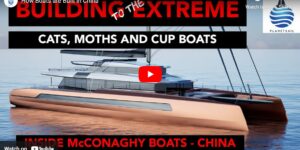
McConaghy MC63 Power Tourer – showing her pace
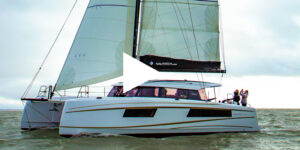
Nautitech 48 Open catamaran – Video

Nautitech 48 catamaran – Interior Design

How the Nautitech 48 catamaran was conceived – Designer Comments.
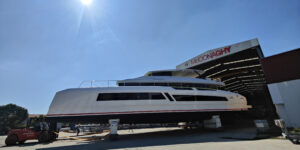
Launched ! – McConaghy MC82P Power
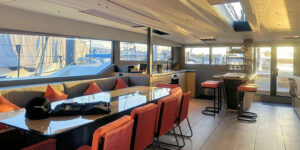
McConaghy 75 catamaran – Stunning NY Loft-Style Interior
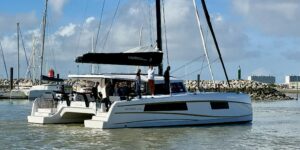
VIDEO: Nautitech 48 catamaran walkthrough. Part 1. EXTERIOR

VIDEO: Nautitech 48 catamaran walkthrough. Part 2. INTERIOR
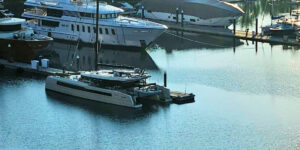
McConaghy 75 Launched.
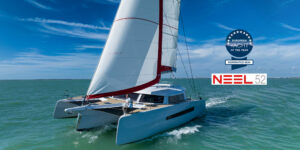
NEEL 52 trimaran nominated European Yacht of the Year 2023
Helpful tips from aeroyacht.
AEROYACHT PUBLICATIONS
Catamaran books by gregor tarjan.

JOIN AEROYACHT’S NEWSLETTER

What a bilge keel is good at, especially when cruising in large tidal areas. Note short rudder on skeg. Pic - Jon Neeves
Keels: Out of sight and out of mind
It is just a lump of stuff at the bottom of the hull: Cruising Helmsman contributor Jon Neeves discusses how important the keel is.
It may be odd but, potential buyers sitting on a demonstrator yacht at a boat show will look at the rig, the galley, the size of the wheel. But it is seldom that anyone enquires of the keel.
The only question asked of the keel relates to draft. Keels invoke so little interest some yacht brochures do not even show any image of them at all. We can thank an Australian, Lexcen or Miller, as having brought keels into international public focus with his (and/or Oossanen and Sloof’s) winged keel for Australia II.
So, given Australia II’s winged keel brought so much advantage to the yacht, it is strange keels are, again, yesterday’s hero.
Traditionally keels many decades ago were full keels and built as part of the hull. Full keels, by definition run 50 per cent of the length of the hull, are seldom seen today and very seldom in Australia. But a local and delightful example would be the Noakes’ restored 80-year-old Maluka.
The main advantage of a full keel for a cruising yacht is that the keel imparts very good directional stability. Set a course and a well-designed, full keeled yacht will hold that course. At anchor full keeled yachts tend to be more stable and do not yaw and veer with normal variability in wind direction. Full keels also impart strength, advantageous if you run aground.
The downside is that the full keel imparts greater wetted surface area and this means less speed. A more modern interpretation of the full keel is a long fin keel, which usually would have reduced surface area compared to an old fashioned full keel but still maintaining that directional stability. Both forms tend to have the rudder incorporated as part of the keel, or with a protective skeg ahead of the rudder.
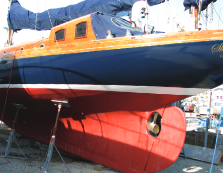
Even long fin keels are not much seen in Australia. An enduring example of a production full keel yacht would be the Fisher 34 or 37/38 built in Mona Vale Sydney some years ago, with a number of well-kept examples sailing today.
Full keel yachts tend to accept heavy weather readily because they were built more solidly: using wood, steel or lots of fibreglass. Fin keels are not new, Herreshoff pioneered the use for inshore racing at the beginning of the 20th century.
But it appears the advent of the fibreglass production yacht almost signalled the end of the full keel and the popularity, at least amongst boatbuilders, of the fin keel. Fin keels come in a variety of forms and the shape has slowly evolved, primarily as yacht designers have had access to better analytical tools.
One major advantage of the fin keel is the simple fact it can be detached, which makes shipping production yachts round the world much cheaper. This, obviously, is a major contributing factor in the popularity.
Fin keels today come in two basic forms: deep or shallow fin, with or without additional bulbs and wings. Earlier fin keeled yachts were sometimes built with bilge or twin, side by side, keels.
Bilge keels allowed yachts to dry out and remain upright but these tended to be restricted to smaller yachts, though there were larger ones. Increased access to marinas and enclosed marinas in areas with big tides, appears to have reduced the popularity amongst modern yacht builders. Bilge keeled yachts tended to heel more than the single keeled equivalents and tacked through larger angles.
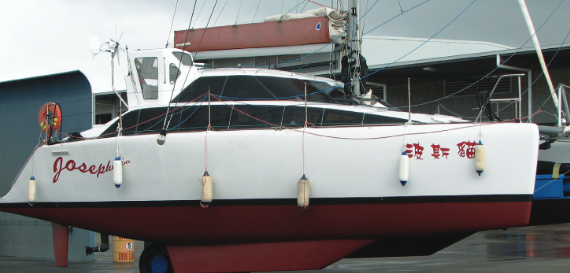
Totally unrelated but multihulls are part of the bilge keeled yacht family with the ability to dry out. Multihulls also have keels to reduce leeway and these are either ‘sacrificial’ mini-keels that will rip off if you ground at speed, or daggerboards. Most cruising catamarans have mini-keels and catamarans with daggerboards that I have cruised with always keep the boards at least part way down to protect propellors and rudders from crab pot lines.
Permanent use of daggerboards appears to negate the use, you might as well have had mini-keels in the first place. Keels are critical to monohulled yachts: they balance the load on the sails so reduce or manage heeling; they reduce leeway, stopping the boat sliding to leeward; and they provide lift counteracting the sideways drive of the sails.
Sadly, monohull keels for cruising yachts are heavy, 25 to 33 percent of overall yacht weight. Plus they restrict the depth to where you can safely travel. Some yacht builders, such as Southerly the better known part of Northshore and Ovni with its alloy yachts, have addressed this shortcoming. The most extreme solution is the lifting keel, the complete keel lifts into a box, manually for smaller keels and hydraulically for larger, usually encased by the saloon table. This is a development that has not proven popular in Australia.
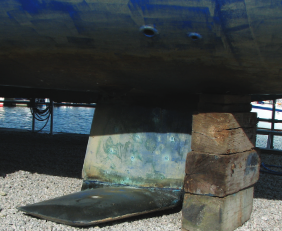
Parker in the UK, who build the International 505 have a 23’ yacht with a lifting keel. When the market was buoyant, they produced larger yachts some with winged lifting keels. Both Elliot and Young, from New Zealand, have had lifting keel designs. Both of these NZ designers also used a lifting keel to allow a yacht to be shipped in a standard shipping container, such as the current Farr 400.
A variant on the lifting keel was a centreboard. The centreboard is effectively a dagger that fits into a base keel and is offered by Jeanneau on some of its Sun Odyssey range. A full lifting keel provides real shoal draft in a monohull, similar to a multihull with mini-keels: 820 millimetre on the 38’ Southerly and 1009mm on its 58’ model; providing the ability to dry out.
These solutions seem neat but a minor problem is maintenance. Moving components, especially underwater, on yachts always generate problems. There have also been problems with fouling of the interior of the box causing the keel to jam.

The longevity of Ovni and Southerly, even in today’s current European economic climate with both brands being expensive, indicates some real success and acceptability. The common solution today to keel design is a shallow or deep fin. Often these are offered as options for the same yacht, sometimes described as a performance or racing keel and the shallower draft version a shallow draft or cruiser keel.
In reality the difference in draft is not great, maybe 300mm to 400mm for an 11m yacht. The difference in performance is marginal, imperceptible to someone cruising but more critical to someone racing. On tests on a 10m yacht the deeper (by 300mm) draft yacht had a 20 degree better tacking angle, less weather helm and heeled about 30 degrees less.
Interestingly, a lifting keel version of the same yacht performed as well as the shallow keeled version, with the bilge keeled version a bit of a dog. Deeper keeled versions of the same cruising yacht will sail better, though you might be pushed to tell the difference. But if your desired cruising area is shallow then a shoal draft keel would obviously be more sensible.
Yachts built specifically for racing have keels that might be considered as extreme, however you want to measure it! Investec Loyal/Maximus has a 20’ keel though the yacht itself is 100’ long. Compare that to the 6’ draft of most larger, around 45’, cruising yachts. Racing yachts also carry protruding torpedo shaped weights at the keel base, ideal for catching crab pot lines or sunfish.
While some racing yachts, when they reach the end of their performance careers, might be considered as the basis for a cruising yacht its keel might be more of a deadweight than intended. Not only state of the art racing yachts are built with protruding bulbs at the base of the keel, many yachts marketed for cruising carry the same sort of handicap. From personal experience a crab pot attached to a short-handed cruising yacht appendage at 2am is not a bundle of laughs.
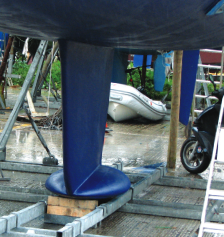
Hanse’s 545 standard keel with forward protruding bulb, for example, has a whopping 9’ draft, is ostensibly sold as a cruising yacht with an interior to match. The Dufour 36 and Beneteau First range also market similarly keeled yachts, but do tend to brand them as performance or racing yachts.
The bulb at the bottom of the fin is the obvious design to enable maximum use of ballast to balance the sail plan: the lower the ballast the less you need carry, which is why racing yachts incorporate such designs. One well-known manifestation of this was the finned keel of Australia II, though technology has moved on. Bulbous bottoms, sometimes tending to fins, have been common on production yachts for a number of years with an enormous breadth of design.
More recently designs have converged. One reason wings lost favour for cruising yachts was their susceptibility to damage when grounding and when grounded, in mud or sand, a large flat bottomed keel was more difficult to free. But Jeanneau nowadays, use the shoal draft wing keel with twin rudders as a way to dry out; so the concept has reputable proponents.
A novel design departure was the tandem keel, two vertical fins with one long interconnecting weight, introduced by Warwick Collins. The idea was to combine shoal draft, ‘full’ keel advantages, a low centre of gravity and produce extra lift, the same as two sails do instead of only one. But the tandem keel has few supporters.
Superficially the tandem keel looks to be a winner, a long shallow keel providing shoal draft and good sea-keeping abilities, but there are obviously technical issues or it would be much more common. Full keels tended to be built hollow and filled with ballast, lead ingots, iron or steel ingots, scrap metal and cemented in place, space left over might be taken up by fuel and water tanks. Modern cruising keels are cast iron or steel with sometimes the inclusion of lead. Lead is 30 percent denser than steel and much more expensive.
Most modern racing yacht keels are built with high tensile steel fins with the ‘torpedo’ weight, sometimes lead but also steel, jointed and bolted, sometimes welded and a flange welded to the top forming a ‘T’ section to allow the keel to be bolted to the hull. Fin keels with a bulb at the bottom are technically the best way to design a keel, as it optimises righting moment or maximises resistance to heeling. Plus, if the fin is thin, minimises drag.
The downside from the cruising yacht point of view is the thinner the fin the more protrusion of the crab pot catcher, the deeper draft and more sensitive directional ability of the yacht.
The very thin fin keels of the high performance racing yacht carry enormous loads and can be made from high tensile steels of the quality produced by the Australian company Bisalloy, coincidentally the same steels used by Manson and Anchor Right for the super high holding power anchors.
Ignoring canting keels, attachment of keels to hulls is by bolts, or studs, through a keel plate in the yacht. Simplistically, the keel is held vertically, the joint surface is liberally coated with marine sealant (FixTech or Sika Flex) the yacht lowered onto the studs in the keel and nuts tightened onto large washers, commonly pieces of stainless steel plate inside the hull and under the cabin sole.
There are two schools of thought regarding how the nuts should be tightened. Some hang the yacht in slings with the keel hanging, others allow the keel to take the full weight of the yacht. The former seems more logical as that is the normal attitude of the yacht in the water with the keel hanging without support.
Given the simplicity with which keels are attached, they are equally easy to remove, arguably more easily than removing the mast. Removing and rebedding a keel is not unknown.
For those who race the keel/hull joint might be faired with epoxy. Castings tend to be a bit rough and steel corrodes, so racing keels are coated and faired and sometimes additionally filled and faired by the owner. If you do ground on something hard and unforgiving it is important to slip the yacht and reseal any damage to the protective coating on the keel and check keel bolts for weepage.
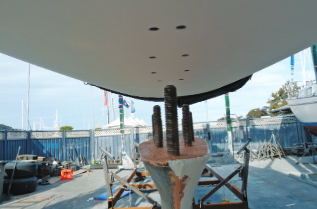
Looking at modern cruise yacht keels from different production yacht builders: Bavaria, Hanse, Beneteau, Jeanneau etcetera, one thing that stands out is that the similarities are greater than any differences. This might explain why keels receive so little mention, they are too similar to differentiate.
Keels tend to have almost vertical leading edges, a tendency to a bulb at the bottom often flattened on the underside to lower the centre of gravity as much as possible, the bulb does not extend forward but does protrude aft of the trailing edge of the keel again keeping the weight low. Bulbs are ‘conventional’, they might have a flattened bottom but no fancy shapes and no fins.
Leading edges of the fin are elliptical and trailing edges narrow, almost to a sharp edge. This gives an indication of what yacht designers, who all have access to the same hydrodynamic data, think is today’s ideal. The optimum draft for a bluewater cruising yacht is 6’. Anymore and there are going to be many places worldwide that you cannot enter; given production yachts today are built for a world market – around 6’ is the limit.
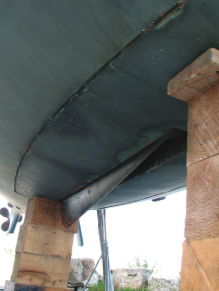
But what is best for you?
Protruding bulbs can catch crab pots, but so too can a near vertical keel leading edge, so some ‘sweepback’ is advantageous. Too much sweepback, common 30 years ago, has been found to be less efficient but again anyone cruising is unlikely to notice. A long keel, fore and aft, will be much more stable when at anchor, but slower to sail. A deeper keel will be more sea kindly, but loses some of its advantage when you run aground in The Great Sandy Strait!
You need to decide what sort of sailing you do. Designers of modern cruising yachts try to make the compromises for you and usually offer two, or occasionally three, keel designs. The very deep draft racing yacht looks sexy and will undoubtedly be fast, but it is usually designed with the idea of crew on the rail.
If you are cruising the crew will be aft in the cockpit, making the yacht slightly stern heavy, so some of the advantage of the fast keel will be lost. Plus you might have the pot catcher and skittish anchored behaviour to contend with. An obvious question to ask: why the inclusion and the detail of racing yacht keels?
Look at the keel of Azurro, it is not much different to today’s cruising yacht keel. Today’s sweep back angles are not so pronounced and our bulbs are bigger but Azurro keels would not be out of place.
Think of Australia II’s winged keel and consider the Parker swing keel illustrated and even today’s shoal draft keel on the Jeanneau Sun Odyssey 379, these modern keels with wings have their genesis with Lexcen and yesterday’s racing yachts. So if performance racing keel technology eventually trickles down to cruising yachts what might we see in the future?
Future forecasts
Investec Loyal’s keel, the 2011 Sydney/Hobart winner, offers a new insight into keel fabrication. The fin is over 6m long, narrowing from 1.0m at the top to 0.7m at the base with an approximate twelve-ton bulb on the bottom, huge loads on such a fine fin. Unlike most, Loyal’s fin is fabricated: 20mm high tensile steel plates, welded, to form a flat hollow tube but including internal longitudinal fillets to add structural strength. The tube is glassed and faired, this makes it hydrodynamic and protects against corrosion.
At the base of the fin is a plate welded at 900 (i.e. it is flat) and this plate is bolted to the torpedo weight with 1.5 inch bolts. Loyal’s keel cants but if it were fixed it could be joined to the hull with a similar plate and bolt arrangement. This method of manufacture is quick and can be completed by anyone with the correct welding skills and, importantly, it works.
The alternative is casting, forging and/or machining; all of which require skills and equipment beyond most boat builders and much more time.
We are not going to see 6m fins but we are already seeing keels similar to today’s shapes, fabricated rather than cast and, as keels come full circle back to the old full keel, that hollow fin may well become the standby fuel tank. With thanks to Noakes and Dovell for sharing the detail on the keel of Investec Loyal.
Jon and his wife Jo have owned their Lightwave 35, Josepheline, for almost 10 years. They manage to get away most years for a long cruise of 3-5 months and more recently their chosen destination has been Tasmania’s west coat.
ALSO ON MYSAILING
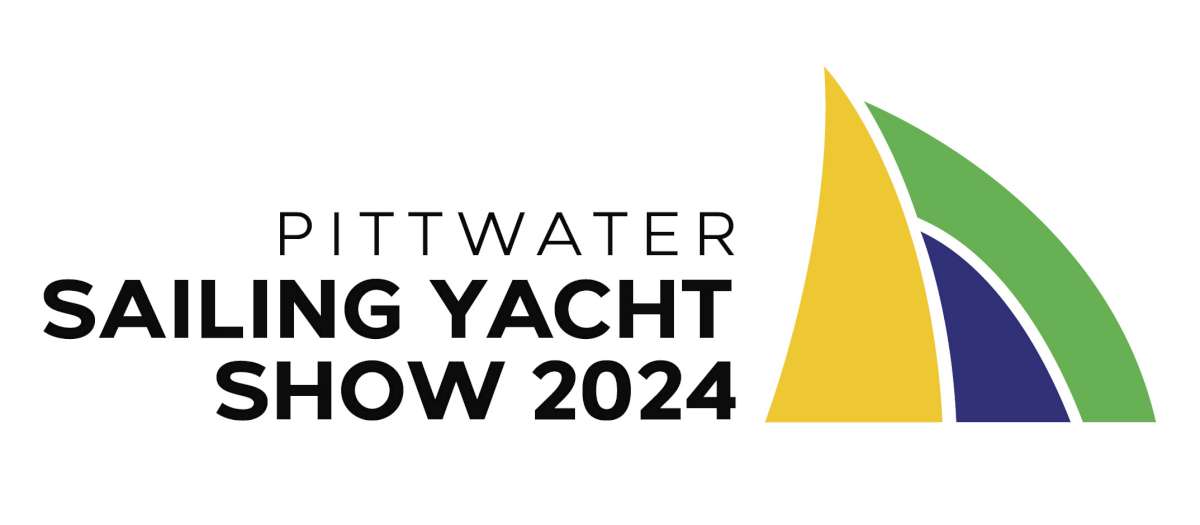
2024 Pittwater Sailing Yacht Show!

2024 NSW O’pen Skiff Championships

Best of the best to contest national yachting title in Newcastle

OGR – Winners and Losers on Leg 4
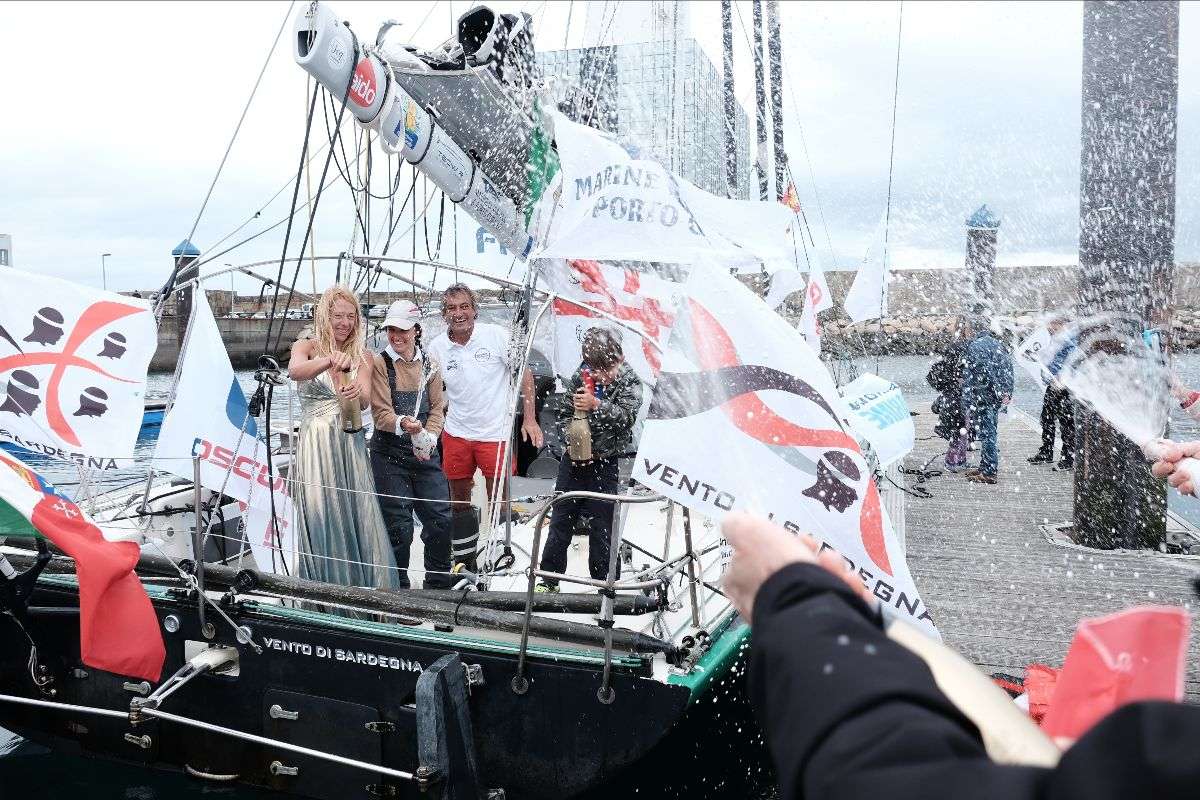
GSC – Andrea Mura reclaims joy on podium
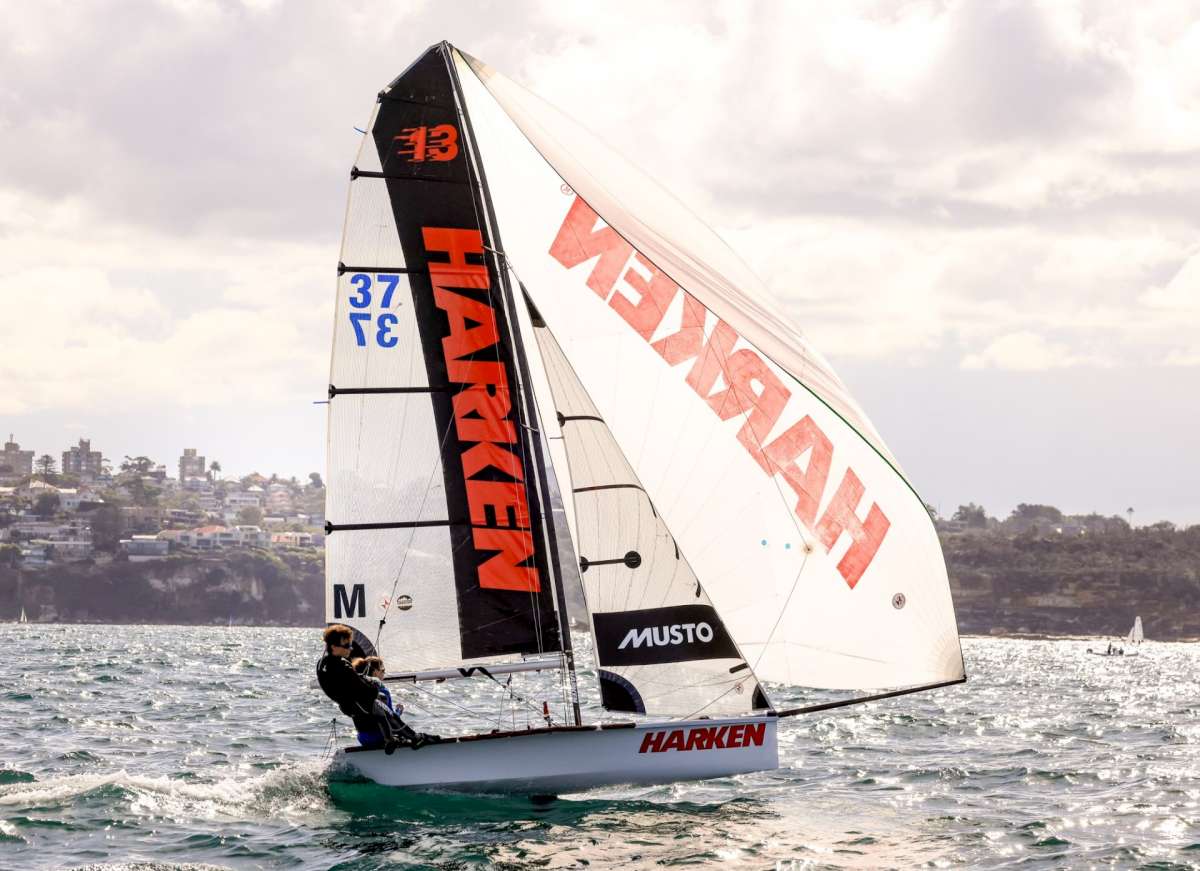
Final Club Championship results at Manly 16ft Skiff Sailing Club
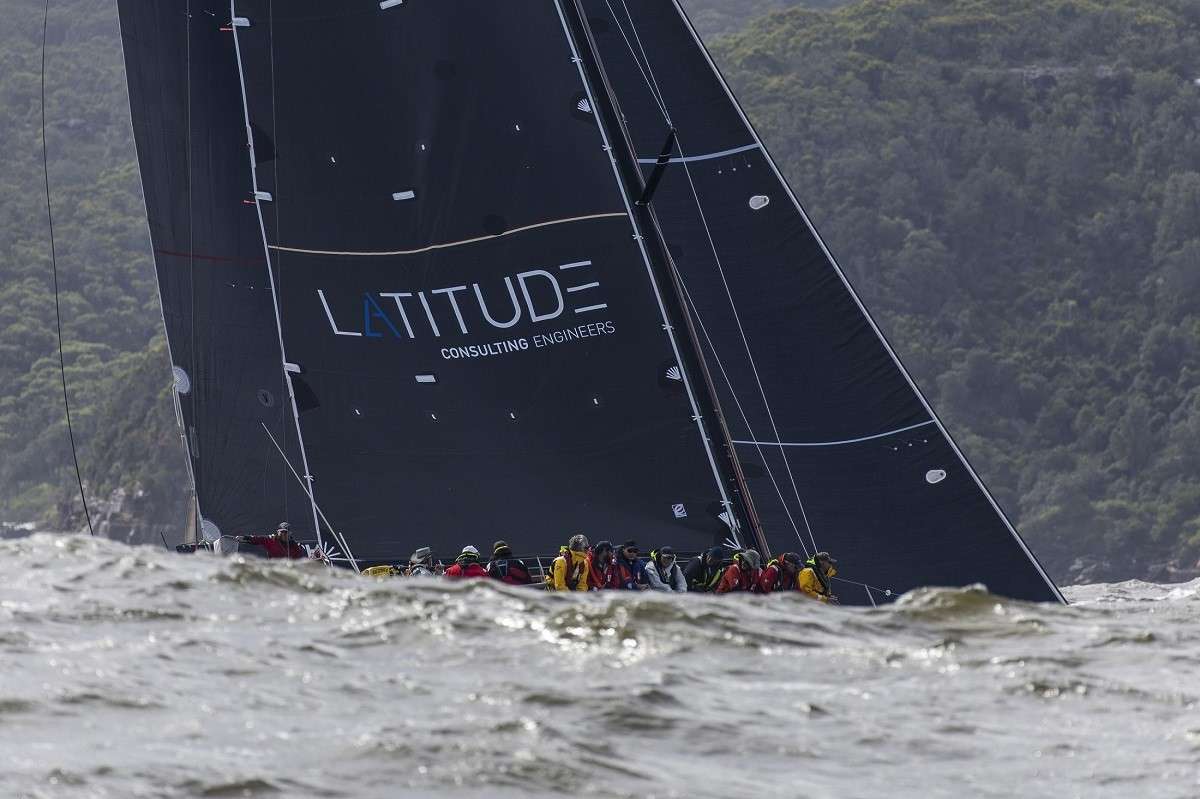
Race is on to win 2024 Pittwater to Coffs Harbour Yacht Race

Outteridge takes the wheel as Schneiter steps back for remainder of Season 4
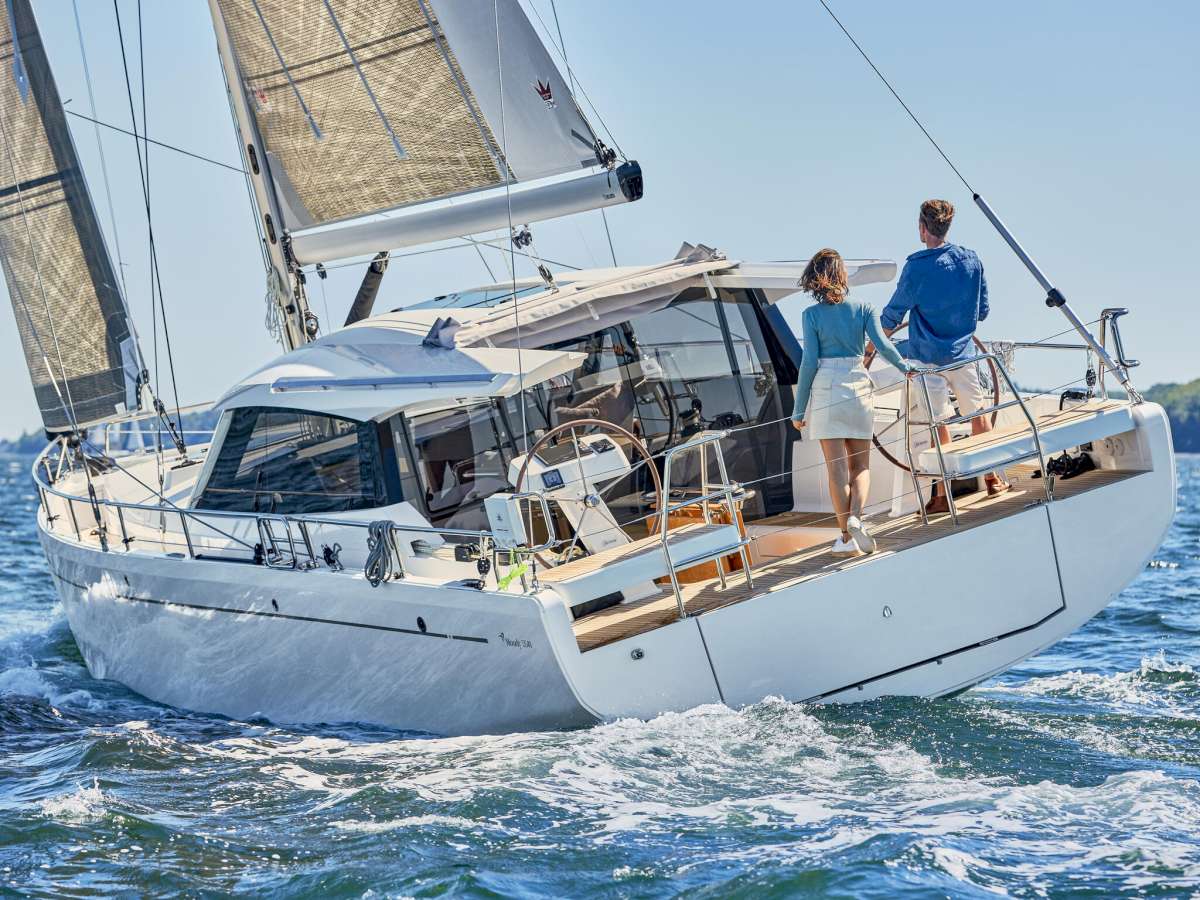
Windcraft presents award-winning sail and power line-up at 2024 Auckland Boat Show

Step into the World of Exploration Boating with the RAND Roamer 29

Tasmanian Sailing – Weekend Wrap

12ft Skiff – Father and son finish top two in NSW Sprint Championship
Join Our Newsletter
- Name First Last
- Email This field is for validation purposes and should be left unchanged.

Read all of the latest sailing news

Dinghy and Yacht Racing News

News from the offshore world

Cruising Stories from around the world

Boats & Gear
The latest boats and yachting gear

Watch everything sailing and boating
Latest Sailing News, Racing, Cruising, Boats, Gear and more

Catamaran Parts Explained: Interactive Guide (For Beginners)
As an Amazon Associate, we earn from qualifying purchases. We may also earn commissions if you purchase products from other retailers after clicking on a link from our site.
Learning a new skill can sometimes be time-consuming, and learning to sail also means learning a new language with tons and tons of new words that, in the beginning, makes no sense at all.
Some of the words you will read about in this article stem from the early days of sailing. Some are only a decade old; in this article, I have tried to compile all the basic terminology that I believe a beginner needs if he or she wants to understand sailing and catamarans.
Feel free to use this article as a resource and come back to it when you want to look something up or just to learn more!
Table of Contents
Main sections on a catamaran
- Hulls; are what separates a cat from other sailboats, a catamaran has two hulls, a trimaran three, and a regular sailboat, aka monohull, has one. The hull is the part of the sailboat which makes it float and to where all other things are attached. The hulls are usually divided into sections, such as usable and non-usable area. An example of a usable area is the engine room.
- Cockpit ; is from where the boat is maneuvered; it is to here that all halyards, sheets, etc. go. The cockpit contains navigation and steering equipment and is from where the sails, rudder, and engine are controlled.
- Deck; is the top part(roof) of a catamaran covering the hulls and bridge deck. The deck is made hard enough to walk on. To the deck, attaches lifelines and other equipment.
- Sugarscoops ; are the aftmost part that gets their name from their scoop-shaped appearance; this is where the deck/cockpit meets that water and usually encompasses a stair or ladder for easy access depending on the size of the boat.
- Cabin; is basically any area on the inside of the boat that is protected from the weather and is made to offer the crew space to rest, eat, and hangout. Inside the cabin, you will find berths (beds), a galley (kitchen), and sometimes specialized areas for repairs or storage.
- Bridgedeck; connects the two hulls; the inside is the cabin, the top part is the deck, and the entire unit is called the bridge deck. Bridge deck clearance, the bridge deck’s height above the water, is an important factor on a catamaran since a too small clearance will create excess noise and vibrations and fatigue not only the crew but also the boat.
Main areas on a catamaran
Bow (front).
Nothing complicated here; the bow is just a nautical term for the foremost part of your boat. This is where the waves and the sea first meet the hull and depending on the type of boat, the bow(s) can be shaped differently.
Center (Middle)
The part between the bow and the stern is rarely called the center part( middle) of a boat; more common is to speak about the specific area situated within the middle part of the vessel, such as the cabin or the mast.
- Cockpit; as mentioned above, here you will (usually) find everything that you need to maneuver and navigate the boat, such as a compass, GPS, sheets, steering wheel, and throttles for the engines. Some boats may not be set up this way and require you to move around the boat to access certain controls.

Cabin (inside of the boat)
The boat’s interior is where you will find everything that is made for the crew’s enjoyment; it is a place to eat, sleep, rest up, and hide away from nasty weather.
- Berths; is a bed; sailors need to sleep too!
- Galley ; is another name for kitchen, usually set up in a very primitive way with a gas stove on a stabilized platform to ensure your food won’t get tossed around.
- Navstation; or navigation station, is a place, usually with a table, chair, and equipment for planning and logging a journey.
Stern (Back)
Stern is the name for the rearmost part of the boat; there is no clear definition as to where the stern stops and other parts begin, so it is something that the crew will have to figure out on their own through good communication.
Communicating directions on a sailboat
Not only will you have to know the different names of different areas on the boat, but it will also be essential to communicate clearly in what direction something is happening, for example, in a situation where you, the captain, want the crew to observe in a specific direction or pick up a piece of gear somewhere on the boat.
Communication on a sailboat is vital when you want to sail safely and efficiently; here, I have listed the words or phrases used to communicate a direction.
- Forward; easy as it sounds, it is the same direction as where the bows are pointing. When giving directions towards or beyond the bow, you will use the word “forward” for example; the fender is located forward of the mast.
- Aft ; is the behind the boat. When you are giving directions towards the stern, you will use the word “aft”; for example, the cockpit is located aft of the mast.
- Port ; this will be your left side. Fun fact, in the good old days, you would always dock with the port on your left side; hence port is the left side. If you ever forget which one is which, “port” has 4 letters and so has the word”left”!
- Starboard ; is your right side!
Types of sails
Sails come in very different shapes and sizes and are a science in itself; in this article, I will focus on the mainsail and three common types of staysail.
- Mainsail; is, per definition, the sail attached to the mast; its sideways movements are controlled by the boom. When the mainsail is triangular in shape, as on most modern sailboats, it is called a Bermuda rig. Most mainsail uses something called battens.
- Staysail; mainly comes in two versions, a staysail that does not overlap the mainsail is called a jib. A staysail that is larger and thus overlaps the mainsail is called a genoa.
- Spinnaker ; is a big balloon-like sail that replaces the jib when sailing downwind.
Parts of a sail
- Luff; the front part of the sail, is connected to the mast through a rail system which makes it possible to hoist or reef.
- Leech; the back part of the sail.
- Foot; the bottom part that reaches from the clew to the tack.
- Clew; back bottom corner.
- Tack; is the front bottom corner (remember “tacking”?).
- Head; is the top triangle of the sail and this is where the mainsail halyard attaches.
- Battens; are pieces of flexible material sewn into the mainsail to increase its aerodynamic shape. Battens can be full length or partial length.
Standing rigging
Everything that keeps the sails and mast upright are parts of the standing rigging; it is comprised of wires, cables, and lightweight metal structures.
- Forestay; usually a metal wire running from the top of the mast to the bow, is sometimes combined with an inner forestay that connects to the mast at a lower point. If the forestay attaches to the top of the mast, the setup is called a masthead rig; if it attaches lower, it is called a fractional rig.
- Backstay ; same as the forestay but attaches to the stern; most catamarans do not employ a backstay system but instead moves the side stays aft.
- Shroud ; much like the forestay but stabilizes the mast sideways and runs from the top to the port or starboard side. Spreaders are used to change the angle of the wire against the mast and better support the mast.
- Sidestay ; connects to the mast below the shrouds and is not pushed outwards with spreaders. On a catamaran, these attach aft of the mast to eliminate the need for a backstay; this makes it possible for a fully battened mainsail with a large roach.
- Jumpers; are used on a fractional rig with diamond shrouds to add structural integrity to the mast without adding excess weight.
- Bowsprit; is a pole amidship at the bow that allows for separation of the tacks (foremost, lower part of the sail) for increasing sail efficiency when using two headsails.
Other stabilizing parts
- Spreaders; act to lessen the angle between the shrouds and the mast; a wider angle will result in forces acting sideways (stabilizing) instead of up and down (bending). This increases stability and decreases the risk of unwanted bending of the mast.
Running rigging
The running rigging on a catamaran is any piece of equipment used to control the shape of the sails, including what is needed to raise them.
- Sheet; are the ropes (or wire, cables, etc.) that connect to the clew of a sail; on a catamaran, it connects to the staysail (genoa or jib, depending on the shape).
- Mainsheet ; is the rope that makes it possible to change the mainsail’s angle; the mainsail can only move in a port to starboard direction(right and left) and not up and down.
- Staysail sheet ; is called after whatever type of sail it is connected to, i.e., jib sheet or genoa sheet. Worth notice is that since the staysail operates on both sides of the catamaran (depending on if your tacking or gybing), it is connected with two ropes, one for the port side and one for the starboard side.
- Halyards ; are the ropes that connect to the top of a sail and make hoisting (or raising) possible. Halyards have different names depending on what sail they are raising, such as Mainsail halyard or jib halyard. Not to be confused with sheets that act upon the sail once they are already hoisted. If the staysail is using a roller furling, then “hosting” is done differently.
- Furling line; is used together with a roller furling and makes it possible to spool up the sail on the forestay instead of raising and lowering. This makes for a faster and easier way to reduce sail area.
- Reefing lines; reefing is when you lower parts of your sail to reduce the sail area and reduce the boat’s power and speed; reefing lines are put through holes in the mainsail and attach to the boom.
- Boom vang; is connected between the boom and deck; it is used to change the mainsail’s shape by pulling downward on the boom. (not very common on Catamarans)
In this category, we will look at the hulls and some of the vital parts that attach to them under the waterline.
- Hulls; differ in their shapes depending on the boat’s purpose, a racing cat would have narrower hulls to reduce drag, and a cruising cat wider hulls to encompass more storage.
- Rudder; is what changes the direction of the boat. When water passes around the rudders(two on a catamaran), it creates a “pushing force” that makes the boat turn. The rudder is connected to a steering wheel or a tiller at the cockpit through chains and linkage.
- Centerboard and daggerboards ; are sorts of keels that can be raised or lowered to attain certain sailing characteristics. When the keel is up, drag is lower, and so is the draft (how deep the boat sticks in the water). A small draft makes it possible to travel in very shallow waters. The difference between a daggerboard and a centerboard is that a centerboard swivels into place, and a daggerboard is pulled straight up.
- Mini-keel; is just what it sounds like; it is a keel but very small (a few inches deep) and has no ballast.
- Crossbeam ; is a multihull-only feature and keeps the two hulls from moving in relation to each other. If the crossbeam is damaged or nonexistent, the bridge deck is the only thing that keeps the hulls in place. This will increase wear and sooner or later lead to cracks, or even worse, separation of hull and bridge deck.
Most catamarans have two engines, one on each hull aft the stern; usually, they are internal with only the propeller in the water. The other option, which is cheaper and most often found on smaller boats, is to have one outboard engine placed amidship (middle).
- Inboard ; engines are situated in a compartment inside the boat at the stern. On an inboard engine, the propeller and the shaft are the only parts outside the hull. Sometimes the prop shaft (propeller shaft) is replaced by a sail drive.
- Outboard ; is a standalone engine usually mounted on the bridge deck amidship(if only one is used) or mounted at the sterns when used in pairs. They are linked together with pushing rods and wires so it can be manipulated from the cockpit.
- Saildrive ; is a type of gearbox that is quieter and vibrates less than a regular propeller and shaft setup.
- Propeller and shaft; are the most common and cheapest way to propel your boat. It is basically just a watertight axel that sticks out of the hull, and at the end of it, you’ll find the propeller.
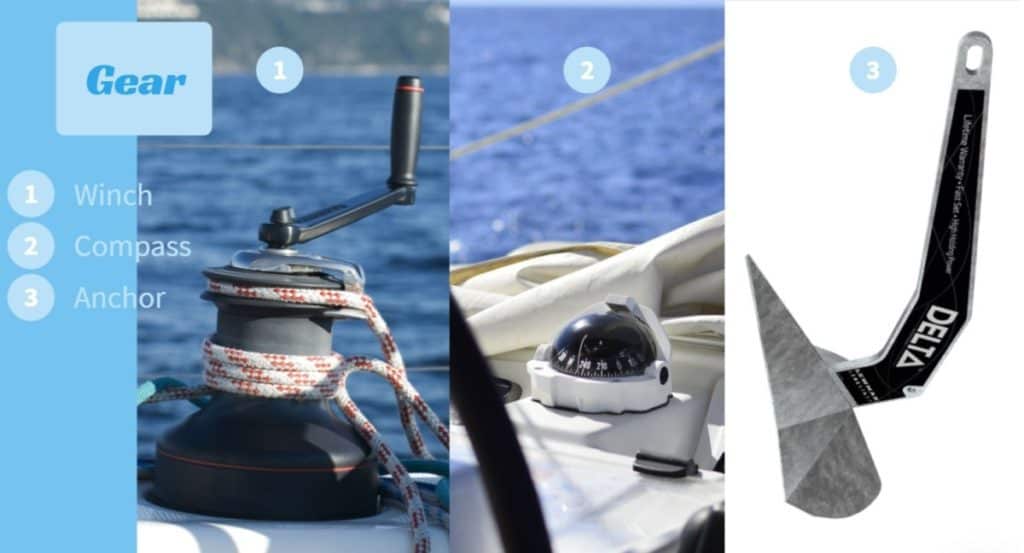
There are so many pieces of gear aboard a catamaran that an all-encompassing article would probably fill up the entire internet. Below I have listed the most common equipment that you will most likely encounter on any sailboat.
- Winches; makes handling lines and ropes much easier. Instead of pulling them with your bare hands, you loop them around your winch and use the handle to crank. Winches come in mechanical style or electrical style.
- Anchors ; is basically just a big hook made to stick to the bottom of the sea. Anchors have different shapes and weights depending not only on the seabed but also on the boat’s weight and size.
- Navigation ; compass, GPS, and maps are all vital pieces of equipment making your trip safe.
- Cleats ; is any equipment that is made to fasten a rope. Cleats come in different configurations; jam, cam, rope clutch, or the most common horn cleat.
- Block ; is a device that can be used in pairs as a pulley (to reduce the force needed to lift something) or on its own to reduce the friction of a rope when the rope can not be drawn in a straight line.
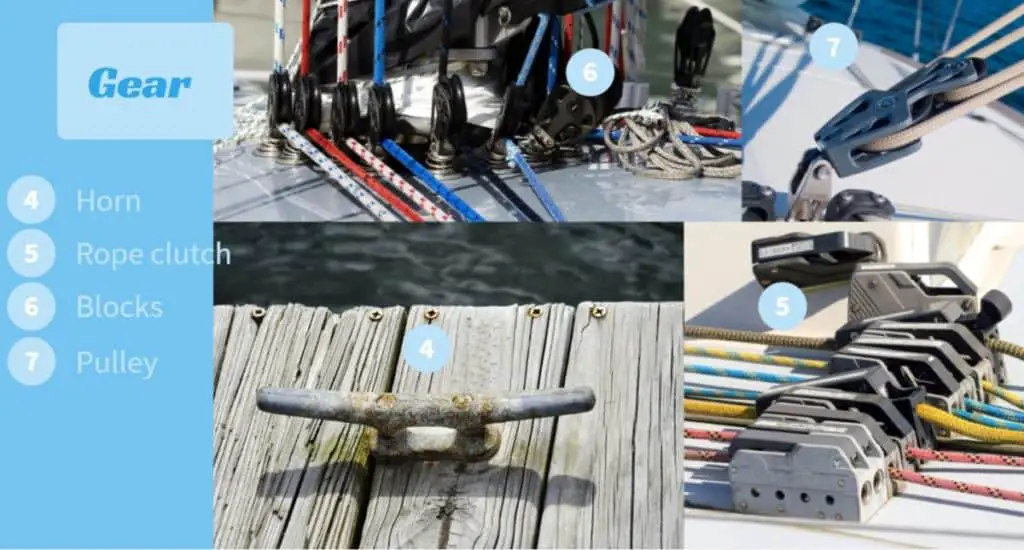
Owner of CatamaranFreedom.com. A minimalist that has lived in a caravan in Sweden, 35ft Monohull in the Bahamas, and right now in his self-built Van. He just started the next adventure, to circumnavigate the world on a Catamaran!
Leave a Reply Cancel reply
Your email address will not be published. Required fields are marked *
Save my name and email in this browser for the next time I comment.
Recent Posts
Must-Have Boat Gear for Catamaran Sailors!
Sailing is probably the most gear-intensive activity I've ever done; there are so many decisions to be made about what gear to buy now, for tomorrow, and what to definitely never buy. The gear on...
6 Best Trailerable Trimarans For Bluewater and Coastal Sailing
Having a boat costs a lot of money, even when you are not using it, marina fees, etc. And once it is in the water most sailors never go very far from their "home marina" and sailing will be somewhat...
Shape & Resistance
A boat's hull shape and the distribution of volume are key factors in determining how it will behave in varying wind and load conditions. The underwater characteristics of a vessel are responsible for allowing a multihull and its cargo to travel through the water. The faster and more effortlessly the twin hulls can displace the surrounding fluid, the less resistance and more efficient a catamaran will be.
Typically modern catamaran designs have sharp bows to drive the vessel through the seas with as little wave making as possible. High freeboard assures a dry ride. Ample buoyancy helps keep the stems out of the water and spray to a minimum. Elliptical sections make up the first third of the hull, providing an easy entry in the water and some means to resist leeway. Towards the middle of the boat, gradually flattening out towards the stern, the sections become semicircular to help distribute buoyancy. These portions help carry payload and facilitate the hull lifting at speed. Basically, the majority of all cruising catamarans share these same underwater features.
Decades ago very seakindly, double-ended hull shapes were the norm as found in the thousands of Wharram catamarans. They were easy to construct, relatively slippery, and provided ample freeboard. Unfortunately they could not carry a lot of cruising gear, had cramped accommodations and were not the best windward performers. Their sharp V-sectioned hulls and rudders were their only means of resisting leeway as they had no leeway preventing devices. Similarly, the narrow asymmetrical type hull, such as found in the Hobie 16 beach catamaran, is hardly used in today's cruising multihull. The idea was to keep the underwater appendage to a minimum and eliminate any keels or daggerboards.
In contrast, the modern catamaran benefits from tank testing and computer-aided design. Composite molding technology allows for infinite shapes and each designer or manufacturer can now realize his idea of the perfect hull shape. Today's mini keels and daggerboards keep the cat hard on the wind and rival the weatherliness of monohull racers.
Drag on the hulls is the main deterrent to speed and has many components. We have to distinguish between water and air drag. Water-induced resistance can be further broken down into drag caused by wetted surface and wave making. Wetted surface, which is the frictional resistance the hulls experience when they are passing through the water, is the main cause of resistance at low speed. Wave making becomes more important as boat speed exceeds hull speed , or 1.34 x square root of the waterline length. Wave making resistance is not as easy to analyze and is more complex than drag caused by wetted surface; it is primarily a function of weight and, secondarily, of hull shape.

Pitch is another form of drag which can slow the boat down. This unwanted phenomenon is directly related to the buoyancy of the extremities and weight distribution. Wave-making resistance caused by the boat's constant plunging will slow a multihull, especially since it has less momentum to drive it through waves as compared to a single-hulled vessel. In addition the airflow over the sails will be disturbed by a constant change of attitude, further hindering efficient progress. Pitching can also be caused by placing items that are too heavy into the extreme ends of the multihull. In addition, various design- and construction-related issues can cause this problem, such as bridge decks extending too far forward of the mast and a high, heavy rig. Solid decking instead of trampoline nets, and/or large protrusions, which strangely some manufacturers claim break up waves, can also cause a hobby-horsing effect. Not only can this result in more wave-making drag than desired, but can seriously tire the crew. Any structure ahead of the mast can cause major slamming when having to face steep seas. Although many cruising catamarans, such as the Prouts, have been built with large bridgedeck structures extending forward to the bows, it is my opinion that an open trampoline, which poses no resistance to wind and seas, is imperative on a good cruising cat.
above High freeboard and angled-out hulls are trademark features of this capable Catana 521. Much thinking has gone into the hull shape of this catamaran, yet the pronounced step running along the inside of the vessel might create some wave slap in some conditions, a typical example of a compromise between space and performance.
Resistance & Performance
Resistance vs. Speed of four different vessel configurations
A. Traditional, heavy displacement monohull cruiser
B. ULD (Ultra Light Displacement) monohull
C. Typical performance catamaran cruiser
D. Racing multihull, with almost no wave making resistance below A popular French catamaran, as photographed out of the water at the Paris Boat Show . Note that there are barely several inches of clearance between the bridgedeck and waterline. The pronounced forward knuckle of the nacelle is claimed to break up waves. In my mind however, there is very little that can resist the continued impact of seas, and any conflict between the wingdeck and waves should be avoided.
Continue reading here: Catamaran Sailboat Wide Bodied Hulls
Was this article helpful?
Recommended Programs

Myboatplans 518 Boat Plans

Boat Alert Hull ID History Search

3D Boat Design Software Package
Related Posts
- Catamaran Design Guide - Catamarans Guide
- Design Dynamics - Catamarans Guide
- Hull Hydrodynamics and Design
- Catamaran vs Monohull - Catamarans Guide
Readers' Questions
What is a characteristic of a catamaran hull?
A characteristic of a catamaran hull is that it has two parallel hulls, which provide greater stability than a monohull vessel and help reduce roll, pitch and yaw. Catamarans also generally require less power to achieve a given speed than a monohull and provide improved handling characteristics in open water.
What may cause hull on catamaran to bend?
Hull flexing on catamarans may be caused by several factors, such as high winds, strong waves, heavy loads, and improper loading. Poorly designed or constructed hulls can also be more vulnerable to flexing.
How to construct catermaran hull show pictures?
Unfortunately, it is not possible to construct a catamaran hull with pictures alone. A catamaran hull is a complex structure that requires precise measurements and calculations in order to ensure that it is structurally sound and performs optimally when in the water. If you would like to learn more about constructing a catamaran hull, you should refer to resources such as books, websites, and experienced boat builders who can provide you with detailed instructions.
How far should a catamaran bridge be of the water?
The height of a catamaran bridge will depend on the size and type of the catamaran. Generally, a bridge should be slightly above the water line, typically between 6 and 12 inches.
How to get catamaran hull resistance?
Catamaran hull resistance is determined by a number of factors, such as the shape of the hull, length and beam dimensions, wetted surface area, type of appendages, and underwater profile. To determine the resistance, the hull needs to be tested in a towing tank or in the open water. The resistance coefficients obtained by testing can then be used to calculate the total resistance of the catamaran hull.
- WORKING FROM MY EXCESS
- EXCESS 14 SERIES
- Excess campus
- EXCESS SAILORS
- PROPULSION & ENERGY
- SAIL & RIGGING
- DESIGN & ARCHITECTURE
- E PROPULSION
- About the Lab

As you will have understood from the video, the shape and dimensions of the keels on a catamaran have a direct impact on the boat’s performance.
It is essential to remember that for the same keel area, a greater keel height (and therefore a greater draft) will significantly improve the catamaran's performance on points of sail closer to the wind, without reducing its performance downwind.
Initial calculations even show that the boat gains 10% “efficiency” if the draft is increased by 200 mm and the “chord” of the keel is shortened.
Of course, this notion is very much linked to your individual use and your sailing needs. For example, some sailors will favor the pleasure of being able to get closer to the shoreline in an anchorage, or be able to take coastal routes, over performance.
The Excess LAB team is currently considering the best compromise regarding the height of the keels on the brand's future catamarans. For information, the current average draft is 1.35 m (Excess 12).

SURVEY - AFT TRANSOMS
Aft transoms.
To share the article, please use the link below
https://lab.excess-catamarans.com/the-draft

Professional BoatBuilder Magazine
Mini 650 rehab.
By Madison Olson , Apr 1, 2022

Sea-trialing Alisia, Olson is aiming to become one of the few American women to ever compete in this race and one of even fewer to sail on a Mini prototype.
Every two years a solo race across the Atlantic leaves from France and finishes in the Caribbean, with a stop in the Canary Islands along the way. It is known as the Mini Transat . While the course is maxi, with 4,050 nm, the boats are mini, measuring 21 ‘ (6.50m) LOA by 10 ‘ (3.05m) beam, with a draft of 6 ‘ (1.83m). There are two classes of boats: series and prototype. While the former are production boats that abide by stricter rules, the prototype class invites designers to experiment with canting keels, water ballast, and foils that lift the boats out of the water to reduce drag and increase speed.
This race is sailed solo with no outside assistance allowed. As with other singlehanded races, skippers may rely on an autopilot to steer. Preparation takes approximately two years, during which sailors must complete a total of 1,500 nm in class Mini regattas with their own boat, and a 1,000-nm solo sail to prove mental and physical fitness.

The Mini 6.50 Alisia is Madison Olson’s ride in the 2023 Mini Transat.
I was raised off the coast of the Florida Panhandle on a 44 ‘ Islander Sloop and have spent my entire life working on sailing yachts. I took my first skipper’s job in the Caribbean at 21, and then sailed offshore, delivering boats between the U.S. and the Caribbean. I skippered my first race program with the W Class in New England at 24, competing in the Candy Store Cup, the Nantucket Race, and the Corinthian Classics. Later I took a position as bow woman on board a Spirit-of-Tradition yacht, which I raced in the New York Yacht Club’s 175th Nantucket Regatta and the famous Les Voiles de Saint-Tropez in France. I crossed the Atlantic three times, raced in numerous inshore and offshore regattas around the world, and now live in Europe full time. In the 2023 race, my aim is to be one of the few U.S. female skippers to compete in the Mini Transat and to race a demanding Mini prototype.
In May 2021, I arrived in La Rochelle, France, to start my story with the Mini prototype #931 named Alisia , designed and built by Etienne Bertrand in 2017. The boat has a carbon hull, a canting keel, an adjustable mast foot, two daggerboards, and a demi-scow bow. The original carbon rig was replaced in 2019 by Heol Composites with another carbon stick and Dyneema standing rigging. The boat had been left unattended on its trailer for a year or more in the back of a maritime industrial zone. The keel was lying underneath the boat with several pockmarks in the lead bulb. The mast was left on deck wrapped in plastic with both ends sticking out. The stanchions had suffered from electrolysis. There was a 3 “ x 3 “ (7.62cm x 7.62cm) area of delamination poking through the faded bottom paint by the opening insert for the keel, a critical area that has to withstand a lot of stress. The lines on the deck were faded from sun exposure. Already there was going to be a lot of work.
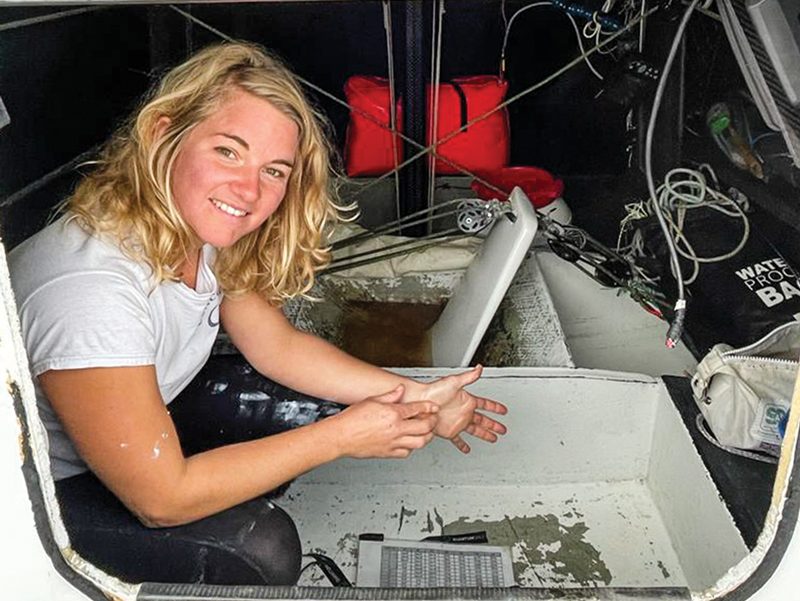
Olson’s refit of the Mini’s keel area was hands-on. She grew up on a 44′ Islander Sloop and has spent her working life on sailboats.
Prepping the Mini 650 Hull
First on my job list was to apply a new carbon patch on the hull and then to reinstall the keel. Everything else could be worked on when the boat was returned to the sea. Prépa Nautic , a small local yard that specializes in work on Minis, came to tow the boat into its warehouse, where I started on the prep work with materials they supplied for this job. I used yellow painter’s tape to separate the bottom paint from the hull and the speedometer. Using 80-grit sandpaper and an orbital sander, I began to expose the carbon around the delaminated carbon sandwich laminate to see how large the damaged section was. Afterward, I sanded approximately 3 “ (76mm) in each direction from the damaged spot to prepare for a patch of Gurit XC411, a ±45° biaxial 408-g/m2 (12.03-oz/sq-yd) carbon fabric, as a reinforcement to protect and strengthen the area. On further inspection we deduced that the area was delaminating because the previous patch had not been installed properly, possibly without vacuum-bagging, and because we found air holes that expanded over time, allowing water intrusion.

With 80-grit sandpaper and an orbital sander, Olson exposed the damage around the keel insert on the outside.
When patching carbon, it is common practice to vacuum-bag it into place, especially during hull repairs, which have to be light and strong. Before installing the patch, I continued to sand the bottom to prep it for painting after the repair. This is where the next problem was discovered. Forward and aft of the keel were cone-shaped reinforcement points that normally would be made of foam-carbon sandwich that is painted afterward. These are extremely important, as they take 70%–90% of the loads when the keel is canted. But the fun did not stop here.
As I sanded away the old paint, it became clear that the old foam had just been painted over. So, as on the other problem spot, I sanded all the outer paint layers until the carbon of the surrounding hull was completely exposed so the patch could bond to the existing hull skin. This part had to be done carefully to avoid sanding into the foam, so I did it by hand after taking down the outer paint layers with the orbital sander. Because I was on a roll, I kept sanding the hull, the keel, and both rudders, which all needed new bottom paint.
There were small holes, or what looked like bubbles, by the hull opening where the keel is inserted. The next step was to fill those holes with West System 105 two-part quick-cure epoxy resin, thickened with silica, using a plastic scraper and removing the excess. Normal drying time would be about 15 minutes, but I gave it an hour due to high humidity that day. Then I lightly sanded with 120-grit to even out the surface and thoroughly wiped it with clean rags and alcohol to remove any dust, grease, oil, etc.

The reinforcement points forward and aft of the keel had delaminated after a previous repair.
Let me give a shout-out to Prépa Nautic, which sent one of its composite specialists to help with the most critical phase of the repair. This shipyard specializes in servicing racing boats and gives sailors access to its tools for repairs at the yard. They were exceptionally helpful and gave me great advice, but it helps to speak French, because most employees do not speak English.
Patching and Bagging the Problem
We first cut a patch of carbon fiber weave to size, applying epoxy to bond it in place. When mixing epoxy, always be aware of the specific ratios, and carefully read the instructions (see Professional BoatBuilder No. 194, “Mixing and Metering Epoxy,” page 54). The many different epoxies all have different mixing ratios, even within one company’s product line. For this repair, we applied an interface layer of West System 105 resin to the hull before adding two layers of carbon patches. The easiest way is to paint the resin onto the fabric that’s on top of a piece of plastic film and then press the wetted fabric into the interface layer of resin on the boat. This removed most bubbles and prevented me from applying too much resin.
The final stage was vacuum-bagging, so we first applied a sticky mastic tape and a vacuum bag connected via a small hose to a pump that provides suction, producing negative pressure in the bag to press the carbon patch down while also removing all the air bubbles, including those you might not see. That is critical, because air bubbles in a carbon repair weaken the entire structure when the resin cures, and potentially leads to failure—not a comforting thought, especially in a keel.

In the last step, the new carbonpatch was vacuum-bagged to the hull.
Depending on the climate, a heater can be an important tool to allow for a better cure, which is what we did. After the repair, a quick sanding and an alcohol wipe-down, it was time to spray-prime the repaired area. For such a small area this job took only about an hour, followed by a day for drying before the International Ultra 300 Hard Antifouling bottom paint could go on. Then it was finally time to mount the canting keel.

Alisia 931 is suspended from straps and raised and lowered manually with chains.
There is a cylindrical metal part, aka canting strut, that slots into two joints that bolt into the bottom of the boat. This gives the keel its canting capability. To prevent corrosion, the insert got a dollop of automotive grease. Winch grease will also work. The boat was suspended on a machine that resembled a Travelift, but instead of hydraulics, we were pulling chain hoists on either side to raise and lower the boat. Once we positioned Alisia 931 exactly above the keel, she was slowly lowered. When her keelbolts protruded far enough through the attachment plate and the nuts were tightened, the boat was ready to be launched.
Solo sailing campaigns are anything but a solo effort. While the skippers might be alone on the boat during the race, they almost always require the help of other people, friends, family, other sailors, and/or contractors with a tricky job or machinery that requires more than one pair of hands to operate safely and efficiently. Prototype boats are notorious for having as much, if not more, work to be done on the hard as in the water.
This was my first taste, and I’ll have more to share as I move forward.
Read more Construction , Racing , Refit , Rovings articles

- CNC Construction on the Rise
How computer-aided design and software-controlled manufacturing technologies have reshaped custom and semi-production boatbuilding.

Marine Trade Education News
Ferretti Group Adds Trade Schools The Italian luxury yacht builder, who owns upscale brands such as Riva, Ferretti, Italma, CRN, Wally, and Pershing, announced the opening of marine trade schools… Read more »

Hull Vane: A Wing With Benefits
Typically, military ships are designed and built for specific missions, not to curb their carbon footprint. However, if the Dutch navy serves as an example, that is about to change…. Read more »

Recent Posts
- How Australia II Got its Wings Part 2: Finding Truth in the Tank
- How Australia II Got Its Wings Part 1: Prelude to a Controversy
- Learn Electrical Systems from Nigel Calder
- PRO-SET Epoxy Named an Official Supplier for New York Yacht Club American Magic, Challenger for the 37th America’s Cup
- Companies (82)
- Construction (105)
- Design (156)
- Drawing Board (8)
- Education (24)
- Environment (15)
- Events (20)
- Materials (48)
- Obituary (17)
- People/Profiles (46)
- Products (16)
- Propulsion Systems (30)
- Racing (15)
- Repair (37)
- Rovings (313)
- Short Cuts (3)
- Sponsored Partner News (13)
- Systems (80)
- Task Sheet (1)
- Uncategorized (28)
- Wood to Glass (7)
ProBoat.com Archives

Do Catamarans Have Keels? Uncovering the Truth
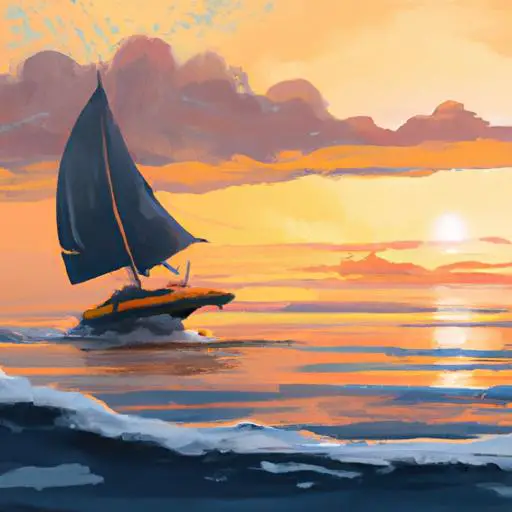
Have you ever wondered what makes a catamaran so different from other types of boats? You may have noticed that a catamaran appears to lack the long, central keel that other boats have.
So, do catamarans have keels? In this article, we’ll go beyond the surface level to uncover the truth about catamarans and keels.
We’ll look at what a catamaran is, what a keel is, and why catamarans don’t have keels.
We’ll explore the advantages and disadvantages of not having a keel, as well as the different types of catamarans and their popular uses.
By the end of this article, you’ll have a better understanding of why catamarans are the way they are.
Table of Contents
Short Answer
Catamarans typically do not have keels.
Instead, they have two hulls, or parallel hulls, connected by a frame.
This design reduces drag and increases stability, allowing catamarans to move quickly and remain upright in rough seas .
Keels are typically seen on monohull boats, which are boats with a single hull.
What is a Catamaran?
A catamaran is a type of boat that is made up of two hulls, or parts, that are connected by crossbeams and struts.
Compared to single-hulled boats, catamarans are more stable and provide greater stability due to the weight being distributed over a larger surface area.
This design also allows catamarans to be more easily maneuvered and to move through shallow waters.
As a result, they are often used for recreational activities such as fishing and sailing.
Catamarans also typically lack a keel, which is a fin-like structure that is found on the bottom of a single-hulled boat that helps provide stability and also helps protect the boat from waves or other environmental forces.
Instead, catamarans rely on their two hulls to provide stability and protection.
What is a Keel?

When it comes to boats, the keel is perhaps one of the most important components.
A keel is a long, heavy, and usually flat piece of metal, wood, or fiberglass that is attached to the hull of a boat and extends below the surface of the water.
This structure serves several important functions, including providing stability, generating lift, and helping to steer the boat.
The keel also serves as a counterweight to the wind and wave forces that push against the hull of the boat.
It also helps to disperse the weight of the boat, allowing it to remain level in the water.
While a keel is present on most traditional boats, it is not present on catamarans.
Why Don’t Catamarans Have Keels?
When it comes to boats, the keel is an integral part of the design.
It provides stability and helps the boat to move through the water.
So why dont catamarans have keels? The simple answer is that they dont need them.
Catamarans are designed with two hulls that are connected by crossbeams and struts.
This design helps to provide greater stability by distributing the weight of the boat over a larger surface area.
The lack of a keel also allows the catamaran to be more easily maneuvered and to move through shallow waters.
This design also allows catamarans to be more fuel efficient than traditional single-hulled boats, as the two hulls help to reduce drag.
Additionally, the lack of a keel reduces the overall weight of the boat, making it easier to transport and launch.
The design of the catamaran also helps to make it more stable in rough seas, making it an ideal choice for recreational activities such as fishing and sailing.
The design of the catamaran also allows it to be more responsive to the waves and wind than traditional single-hulled boats, as the two hulls move independently and respond to the conditions more quickly.
This makes them ideal for sailing and other activities, as they are able to turn faster and more accurately than single-hulled boats.
In short, the lack of a keel on catamarans is one of the main advantages of the design.
The two hulls provide greater stability and maneuverability, and the overall lighter weight of the boat makes it easier to transport and launch.
The lack of a keel also makes the catamaran more fuel efficient and responsive to the waves and wind.
As a result, catamarans are often used in recreational activities such as fishing and sailing.
Advantages of Not Having a Keel

The absence of a keel on catamarans can be advantageous in many ways.
First, it provides greater stability than traditional single-hulled boats.
Because the weight of the boat is distributed over a larger surface area, the catamaran’s two hulls are able to withstand more force from waves and other conditions.
This makes them an ideal choice for recreational activities, such as fishing and sailing, as they are able to remain steady in choppy waters.
Furthermore, the lack of a keel allows catamarans to be more maneuverable than single-hulled boats.
Without the additional weight of a keel, catamarans can turn more quickly and easily, making them ideal for racing and navigating through tight spaces.
Additionally, the absence of a keel allows catamarans to move through shallow waters, which is beneficial for exploring areas that would be inaccessible to single-hulled boats.
Lastly, the absence of a keel also contributes to the overall design of the catamaran, as the two hulls are connected by crossbeams and struts.
This design helps to increase stability and reduce rolling.
Additionally, it can provide greater visibility, as the two hulls can extend farther out from the center of the boat, providing a better view of the surroundings.
Disadvantages of Not Having a Keel
The lack of a keel on catamarans can be both a blessing and a curse.
While having two hulls instead of one provides greater stability, this also means that the catamaran is more vulnerable to strong winds and choppy waters.
Without the keel acting as a counterbalance, the catamaran can be more easily pushed off course.
This is especially true if the boat is not well-balanced, as the weight distribution is less evenly distributed without a keel.
Additionally, a keel can provide additional lift to the boat, which can help to increase speed and maneuverability.
Without a keel, catamarans will often be slower and less responsive than a traditional single-hulled boat.
Finally, the lack of a keel also means that the catamaran is more vulnerable to capsizing, as the boat is more top-heavy without the keel acting as a counterbalance.
Different Types of Catamarans

When it comes to catamarans, there are several types that have different designs and features.
The most common type of catamaran is the pontoon catamaran, which is composed of two hulls that are connected with beams and struts.
This type of catamaran is often used for recreational activities, such as fishing and sailing, because of its stability and ability to maneuver in shallow waters.
Another type of catamaran is the trimaran, which is composed of three hulls connected by beams and struts.
The trimaran is designed to provide more stability than the pontoon catamaran, and is often used for racing and long-distance sailing.
The third type of catamaran is the hydrofoil catamaran, which is composed of two hulls that are connected with beams and struts.
This type of catamaran is designed to reduce drag and increase speed by using hydrofoils to lift the hulls out of the water.
This type of catamaran is often used in high speed boat racing and can reach speeds of up to 40 knots.
Finally, there is the semi-submersible catamaran, which is designed to be partially submerged in water.
This type of catamaran is often used for research and exploration, and can be used to explore shallow waters where traditional boats are not able to go.
No matter the type of catamaran, they all have one thing in common: they do not have a keel. Instead, they are designed with two or more hulls that are connected by crossbeams and struts. This design helps to provide greater stability and allows catamarans to be more easily maneuvered in shallow waters. As a result, catamarans are often used in recreational activities, such as fishing and sailing.
Popular Uses for Catamarans
Catamarans are popularly used in recreational activities such as sailing, fishing, and even racing.
Their unique design allows them to maneuver easily in shallow waters, which makes them ideal for these activities.
Additionally, catamarans are often used for chartering and cruising, as they are more stable than traditional single-hulled boats.
The lack of a keel also allows catamarans to move more quickly through the water.
Furthermore, the spacious living area provided by the two hulls makes catamarans an ideal choice for extended trips and vacations.
Catamarans are also used in commercial activities such as ferrying, transport, and research.
Their stability makes them perfect for transporting cargo and passengers over long distances.
Additionally, the two hulls provide more room for researchers to conduct experiments and surveys.
The shallow draft of catamarans also allows them to navigate shallow waters, which makes them ideal for research purposes.
Lastly, catamarans are also used in rescue and emergency operations, as their stability makes them perfect for difficult and dangerous conditions.
Final Thoughts
In conclusion, catamarans are unique boats that are designed without a keel for added stability and maneuverability.
While they do not have the same advantages as a single-hulled boat with a keel, they are popularly used for recreational activities such as fishing and sailing.
With the knowledge of why catamarans do not have keels, you can now confidently choose the right boat for your next adventure.
James Frami
At the age of 15, he and four other friends from his neighborhood constructed their first boat. He has been sailing for almost 30 years and has a wealth of knowledge that he wants to share with others.
Recent Posts
Does Your Boat License Expire? Here's What You Need to Know
Are you a boat owner looking to stay up-to-date on your license requirements? If so, youve come to the right place! In this article, well cover everything you need to know about boat license...
How to Put Skins on Your Boat in Sea of Thieves? (Complete Guide)
There is a unique sense of pride and accomplishment when you show off a boat you customized to your exact specifications. With Sea of Thieves, you can customize your boat to make it look like your...
Star ratings are based on a self-evaluation by the hotel as well as the experiences of HRS and HRS customers. You can find details under Terms and Conditions and FAQs.
Mini-Hotel Nabat Palace (Kotel'niki)

- Exkl. Frühstück
Cancellation not free of charge
Deposit required
- No credit card required
Type of booking
The hotel offers you two different choices for the booking - a standard booking (arrival before 6 PM Hotel-local time) or a guaranteed booking (arrival after 6 PM possible, requires a credit card number). The hotel is not permitted to charge the credit card for payments.
Cancellation
Rate description

- More rooms & persons
Would you like to book more than 9 rooms? Click here.
Hotel availability is checked ...
Important information
Style of hotel and ambience.
Make yourself at home in one of the 10 air-conditioned rooms featuring LCD televisions. Complimentary wireless Internet access is available to keep you connected. Private bathrooms with showers feature complimentary toiletries and bathrobes. Conveniences include phones and blackout drapes/curtains, and housekeeping is provided daily.Featured amenities include dry cleaning/laundry services, a 24-hour front desk, and a safe deposit box at the front desk. A roundtrip airport shuttle is provided for a surcharge (available 24 hours), and free self parking is available onsite.Enjoy recreation amenities such as an outdoor tennis court or take in the view from a garden. Additional amenities at this hotel include complimentary wireless Internet access and a picnic area.Recreational amenities at the hotel include an outdoor tennis court.Satisfy your appetite at the hotel's coffee shop/café.
Location of the hotel
With a stay at Mini-Hotel Nabat Palace in Moscow, you'll be 10.8 mi (17.3 km) from Red Square and 10.8 mi (17.3 km) from St. Basil's Cathedral. This hotel is 10.4 mi (16.7 km) from Kremlin Armoury Museum and 10.5 mi (16.8 km) from Pushkin Museum of Fine Arts.
Reception open During the week Not occupied At weekends Not occupied Check-In : - Check-Out : -
The following credit cards are accepted by Mini-Hotel Nabat Palace (Kotel'niki) :
Service & facilities
- Hotel-owned car park
- Café/bistro
- Garden/park
- Outdoor swimming pool
- WLAN with Internet access in lobby
Room facilities
- Telephone by the bed
- Iron + ironing board
- Temperature controls
- Centrally controlled ventilation
- Bathroom with shower
In-house services
- Pets permitted
- Safety deposit boxes at reception
- Laundry service
Show more less
Mini-Hotel Nabat Palace (Kotel'niki): Location and distance
Frequently asked questions about mini-hotel nabat palace (kotel'niki), does mini-hotel nabat palace offer parking spaces for guests, can i have breakfast in mini-hotel nabat palace, at what time can you check in at the mini-hotel nabat palace at the earliest, what is the latest time to check out, what are the advantages of booking the mini-hotel nabat palace via hrs, is there a restaurant in the mini-hotel nabat palace, is the hotel barrier-free, are the hotel rooms equipped with air conditioning, is it possible to cancel my booking at the mini-hotel nabat palace free of charge, which payment methods can i use to pay in mini-hotel nabat palace.
- Eurocard/MasterCard
- American Express
Can I collect miles and points during a trip?
Hotels in the area.
Hotel Mercure Moscow Paveletskaya
Bentley Hotel
Hotel Korston Moscow
Hotel The St. Regis Moscow Nikolskaya
Metropol Moscow Historical Hotel
Savoy Hotel
Hotel National, a Luxury Collection Hotel, Moskau
Apart Hotel Naumov-Sretenka
Grada Boutique Hotel
Eliseeff Arbat Hotel
Popular travel destinations in Russia
Sankt-Peterburg
Yekaterinburg
Nizhniy Novgorod
Novosibirsk
Kaliningrad
Rostov-on-Don
Chelyabinsk
Vladivostok
- For large companies
- Jobs & Karriere
Play over 200 games. No ads. No in-app purchases.

Apple Arcade
Sago Mini Trips+ 4+
Travel, explore, and play.
- Expected Apr 4, 2024
- This content may change without notice, and the final product may be different.
Screenshots
Description.
HIT THE ROAD WITH YOUR SAGO MINI FRIENDS! Ready for adventure? Sago Mini Trips+ brings together four fan-favorite preschool games into one kid-friendly app – Road Trip, Boats, Planes, and Trains. Travel to far-off destinations with your Sago Mini friends and discover lots of fun and surprises along the way! With no WiFi or internet required, it’s perfect for on-the-go playtime or your next big trip. PACK YOUR BAGS Choose Harvey, Jinja, Robin, or Jack, and help them pack for their getaway! Fill up their suitcase with clothes, accessories, or even a snack or two for the road. Once you’re all set, close up your suitcase and head to the garage to pick out your ride. PICK YOUR VEHICLE Set sail, ride the rails, take flight, or hit the road with tons of fun vehicles to choose from. Have you ever traveled by pickle boat? How about a chicken car that lays eggs? Find plenty of super silly planes, trains, boats, and cars including an ice cream truck, a steam train with a fishbowl car, a rocket ship, and much more. With an additional 10 new vehicles exclusive to Sago Mini Trips+, you can hop aboard a dinosaur train, a teacup boat, or a lemon car, too! Travel solo or pick a friend or two to come along. START EXPLORING Suitcase? Check. Sweet ride? Check. Travel buddies? Check. It’s time to go! Take a train ride through some snowy mountains, soar into the clouds to find out if pigs really can fly, or make friends with a friendly sea monster on the high seas. Need a break? Make a pit stop for a car wash or to refuel before hitting the road again. Keep your eyes out for fun surprises at every turn! Once you arrive at your destination, snap a picture then start all over again with a new vehicle and a new destination. In Sago Mini Trips+, there’s always an adventure just around the corner. Bon voyage! FEATURES • Four fan-favorite games in one kid-friendly app – Planes, Trains, Road Trip, and Boats • Play on-the-go without WiFi or internet • Imaginative, open-ended play designed to support preschoolers’ development • Calming and frustration-free screen time • With no time limits or rules, kids can play their way • Perfect for kids aged 2-5 Privacy Policy Sago Mini is committed to protecting your privacy and the privacy of your children. We adhere to the strict guidelines set forth by COPPA (Children’s Online Privacy Protection Rule), which ensure the protection of your child’s information online. Privacy policy: https://sagomini.com/privacy-policy-trips/ Terms of use: https://sagomini.com/terms-of-use/ About Sago Mini Sago Mini is an award-winning company devoted to play. We make apps, games and toys for preschoolers worldwide. Toys that seed imagination and grow wonder. We bring thoughtful design to life. For kids. For parents. For giggles. Find us on Instagram, Facebook, and TikTok at @sagomini.
App Privacy
The developer, Sago Mini , indicated that the app’s privacy practices may include handling of data as described below. For more information, see the developer’s privacy policy .
Data Not Linked to You
The following data may be collected but it is not linked to your identity:
- Identifiers
Privacy practices may vary, for example, based on the features you use or your age. Learn More
Information
English, Arabic, Dutch, French, German, Italian, Japanese, Korean, Portuguese, Russian, Simplified Chinese, Spanish, Traditional Chinese, Turkish
- Developer Website
- App Support
- Privacy Policy
You Might Also Like
Farming Simulator 20+
Fledgling Heroes
Pro Snooker & Pool 2024+
My Town Home - Family Games+
My Little Pony: Mane Merge
Crayola Adventures

Current time by city
For example, New York
Current time by country
For example, Japan
Time difference
For example, London
For example, Dubai
Coordinates
For example, Hong Kong
For example, Delhi
For example, Sydney
Geographic coordinates of Elektrostal, Moscow Oblast, Russia
City coordinates
Coordinates of Elektrostal in decimal degrees
Coordinates of elektrostal in degrees and decimal minutes, utm coordinates of elektrostal, geographic coordinate systems.
WGS 84 coordinate reference system is the latest revision of the World Geodetic System, which is used in mapping and navigation, including GPS satellite navigation system (the Global Positioning System).
Geographic coordinates (latitude and longitude) define a position on the Earth’s surface. Coordinates are angular units. The canonical form of latitude and longitude representation uses degrees (°), minutes (′), and seconds (″). GPS systems widely use coordinates in degrees and decimal minutes, or in decimal degrees.
Latitude varies from −90° to 90°. The latitude of the Equator is 0°; the latitude of the South Pole is −90°; the latitude of the North Pole is 90°. Positive latitude values correspond to the geographic locations north of the Equator (abbrev. N). Negative latitude values correspond to the geographic locations south of the Equator (abbrev. S).
Longitude is counted from the prime meridian ( IERS Reference Meridian for WGS 84) and varies from −180° to 180°. Positive longitude values correspond to the geographic locations east of the prime meridian (abbrev. E). Negative longitude values correspond to the geographic locations west of the prime meridian (abbrev. W).
UTM or Universal Transverse Mercator coordinate system divides the Earth’s surface into 60 longitudinal zones. The coordinates of a location within each zone are defined as a planar coordinate pair related to the intersection of the equator and the zone’s central meridian, and measured in meters.
Elevation above sea level is a measure of a geographic location’s height. We are using the global digital elevation model GTOPO30 .
Elektrostal , Moscow Oblast, Russia
Electrostal History and Art Museum

Most Recent: Reviews ordered by most recent publish date in descending order.
Detailed Reviews: Reviews ordered by recency and descriptiveness of user-identified themes such as wait time, length of visit, general tips, and location information.
Electrostal History and Art Museum - All You Need to Know BEFORE You Go (2024)
- (0.19 mi) Elektrostal Hotel
- (1.21 mi) Yakor Hotel
- (1.27 mi) Mini Hotel Banifatsiy
- (1.18 mi) Elemash
- (1.36 mi) Hotel Djaz
- (0.07 mi) Prima Bolshogo
- (0.13 mi) Makecoffee
- (0.25 mi) Amsterdam Moments
- (0.25 mi) Pechka
- (0.26 mi) Mazhor

IMAGES
VIDEO
COMMENTS
The boat with a fixed keel is likely to point nearly as high as one with dagger boards, but will lose ground though increased leeway. As the wind strength increases the fixed keels will typically operate much more efficiently and from personal experience the difference in performance between two similar cats -one with efficient fixed keels, the ...
See the basic idea of how the sacrificial mini keels on the Fountaine Pajot sailing catamaran range work to provide a safe and stable platform when beaching ...
Not only should this brief discussion illustrate the basic virtues and drawbacks of daggerboards and mini keels on multihulls, but also point out their active and passive safety aspects. ... It should be noted that anything (even a barn door) surfs in the right conditions. Even keel catamarans can surf at speeds up to 30 knots down large seas ...
Posts: 40. Dagger boards, mini-keels or swing keels. Most cruising catamarans have either mini-keels or dagger boards. The mini-keels are fixed and do not obtrude into the hulls. The dagger boards provide better performance, especially upwind, and permit lifting to create a smaller draft. But they require a boxy daggerboard case which obstructs ...
Make sure the surface is smooth and ready for painting. Apply marine paint to the keel, using several coats to ensure durability. Install the keels: Consult your catamaran's design or consult with a boat builder to determine the optimal placement for the mini keels. Install the keels onto the catamaran's hulls using marine-grade screws or bolts.
Mini keels and fixed rudders do a more adequate job of protecting the hull in most conditions - although care must still be taken. It's safe to beach Seawinds with mini-keels. As shown in the picture above, owners can beach their boats not only in the case of an emergency such as a storm, but as a way to conduct checks or even service the ...
Woods 36 Vardo with Keels. So there's the two factors: one is the the sea kindliness of having daggerboards, and the other is the better performance. A daggerboarded boat is always better, but it does have some disadvantages. The main one is that if you want to beach your boat or dry it out.
This is similar to modern mini keels on catamarans; they too are constructed to detach if hit hard enough, the keels fall off, but the hull stays intact. Weaknesses Both systems offer a risk of getting stuck; some say this is a bigger issue with daggerboards, and they more often fail than the centerboard style.
Daggerboards. The majority of today's cruising catamarans are equipped with mini keels for reliable and hassle-free operation. There are fewer than a handful of production daggerboard catamarans, which provide the sailor slightly more pointing ability and other advantages as illustrated in previous chapters. Their operation is generally ...
Good directional stability depends on the hull balance. A properly designed daggerboarded boat will sail as straight as a LAR keel one, and have the additional benefit of being quicker to tack and maneuver when necessary. Finally, if you run aground, you can lift the boards to get off, but remain stuck with keels.
It is striking (no pun intended), how few sailors care to know about fundamental design and construction details of their boats' underwater appendages. Not only are there obvious handling differences between mini keels, daggerboards and centerboards - but also various ways they are constructed. This knowledge might save your life one day. When shopping for your multihull, make sure you ...
The author's own catamaran with mini keels, suitable for beaching and protecting the hulls in groundings. Pic - Jon Neeves. Totally unrelated but multihulls are part of the bilge keeled yacht family with the ability to dry out. Multihulls also have keels to reduce leeway and these are either 'sacrificial' mini-keels that will rip off if ...
Mini-keel; is just what it sounds like; it is a keel but very small (a few inches deep) and has no ballast. Crossbeam; is a multihull-only feature and keeps the two hulls from moving in relation to each other. If the crossbeam is damaged or nonexistent, the bridge deck is the only thing that keeps the hulls in place.
In contrast, the modern catamaran benefits from tank testing and computer-aided design. Composite molding technology allows for infinite shapes and each designer or manufacturer can now realize his idea of the perfect hull shape. Today's mini keels and daggerboards keep the cat hard on the wind and rival the weatherliness of monohull racers.
Some Balance 526 buyers have requested that Balance Catamarans consider producing boats with mini-keels rather than dagger-boards, to both reduce operational...
It is essential to remember that for the same keel area, a greater keel height (and therefore a greater draft) will significantly improve the catamaran's performance on points of sail closer to the wind, without reducing its performance downwind. Initial calculations even show that the boat gains 10% "efficiency" if the draft is increased ...
Mini 650 Rehab. compete in this race and one of even fewer to sail on a Mini prototype. Every two years a solo race across the Atlantic leaves from France and finishes in the Caribbean, with a stop in the Canary Islands along the way. It is known as the Mini Transat. While the course is maxi, with 4,050 nm, the boats are mini, measuring 21 ...
Just saw a catamaran on yacht hub built by Choy/Csk catamarans in Hawaii that has been refitted in Philippines Just wondering if anyone knows anything about them or how they sail , never seen a sailing cat that doesn't have mini keels or daggerboards . I'm guessing upwind is no chance or are those hulls deep enough to be workable
Short Answer. Catamarans typically do not have keels. Instead, they have two hulls, or parallel hulls, connected by a frame. This design reduces drag and increases stability, allowing catamarans to move quickly and remain upright in rough seas. Keels are typically seen on monohull boats, which are boats with a single hull.
1. Electrostal History and Art Museum. 2. Statue of Lenin. 3. Park of Culture and Leisure. 4. Museum and Exhibition Center. 5.
Mini-Hotel Nabat Palace (Kotel'niki) Bratislavskaya 6 , 109341 Kotel'niki . 1/1. 26.03 - 27.03 Rooms:1 - Guests:1 Your HRS offer. Your travel dates Arrival: 26.03.2023 Depature: 27.03.2023 Duration: 1 Traveller: 1 Rooms: Change travel dates Check-in. Single room Double room Guests.
Sago Mini Trips+ brings together four fan-favorite preschool games into one kid-friendly app - Road Trip, Boats, Planes, and Trains. ... boats, and cars including an ice cream truck, a steam train with a fishbowl car, a rocket ship, and much more. With an additional 10 new vehicles exclusive to Sago Mini Trips+, you can hop aboard a dinosaur ...
Geographic coordinates of Elektrostal, Moscow Oblast, Russia in WGS 84 coordinate system which is a standard in cartography, geodesy, and navigation, including Global Positioning System (GPS). Latitude of Elektrostal, longitude of Elektrostal, elevation above sea level of Elektrostal.
Most Recent: Reviews ordered by most recent publish date in descending order. Detailed Reviews: Reviews ordered by recency and descriptiveness of user-identified themes such as wait time, length of visit, general tips, and location information.